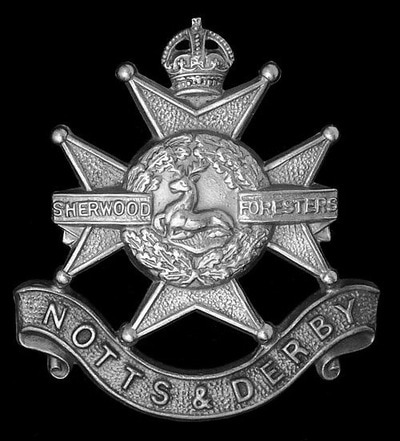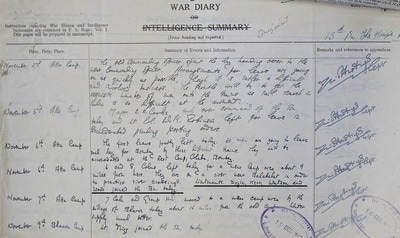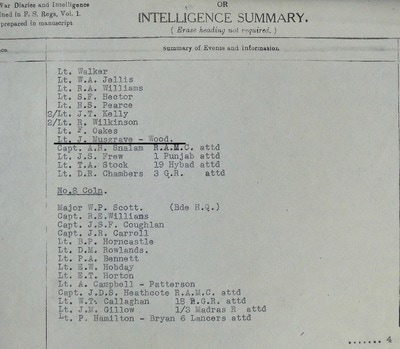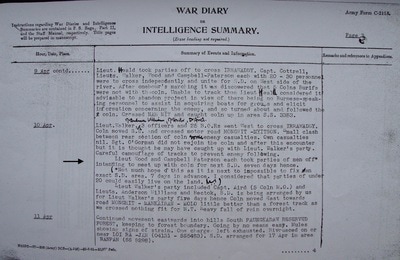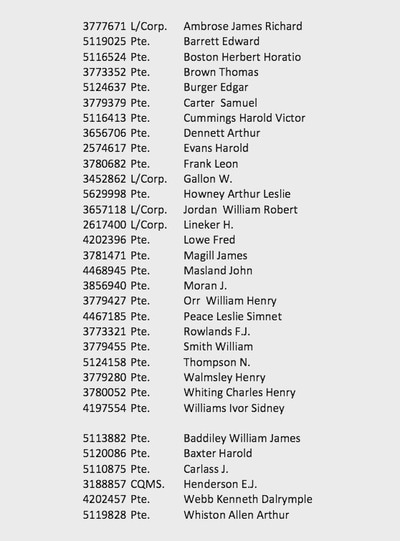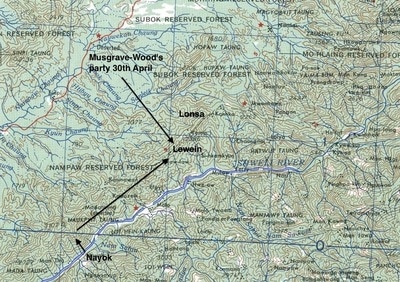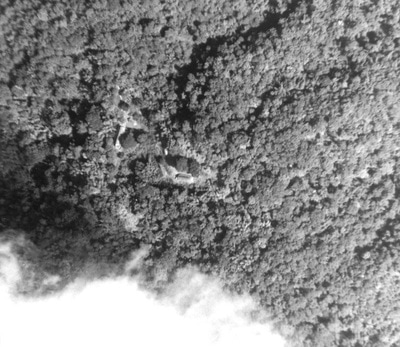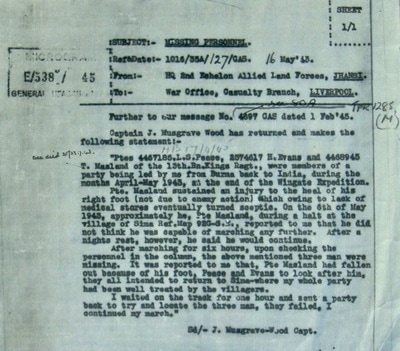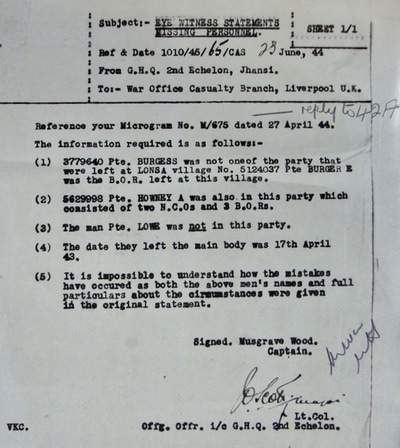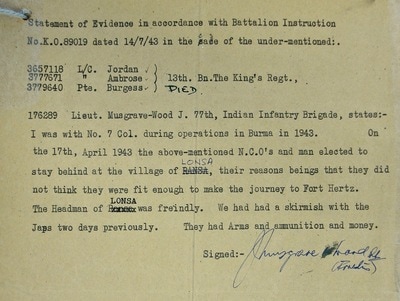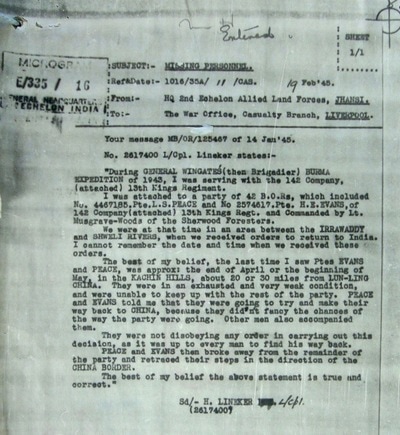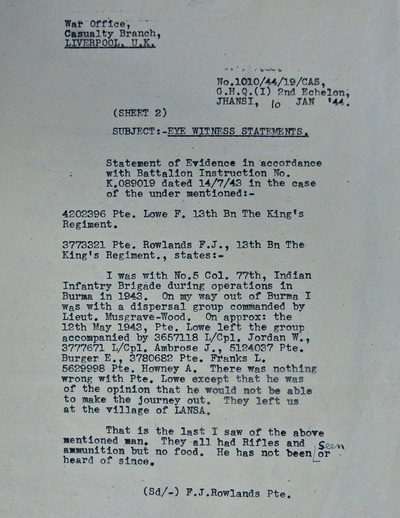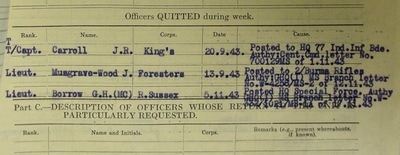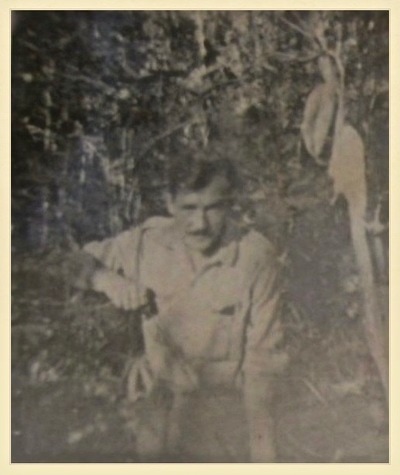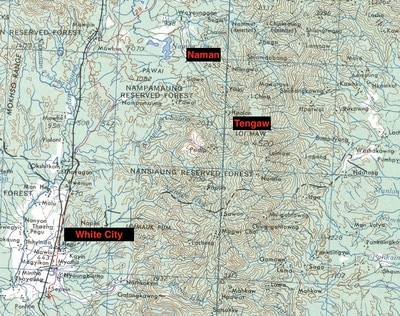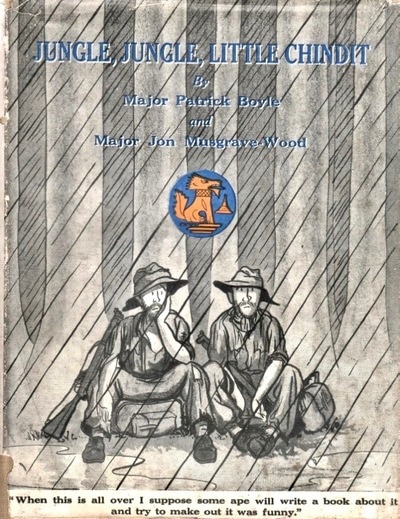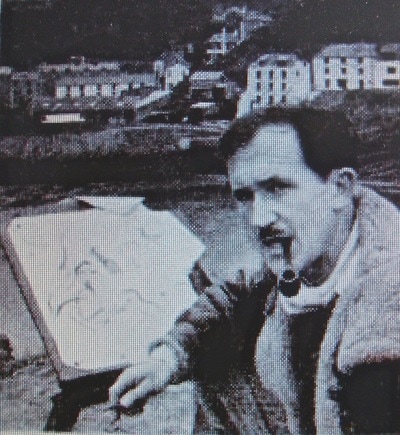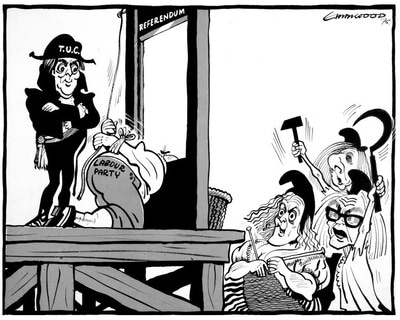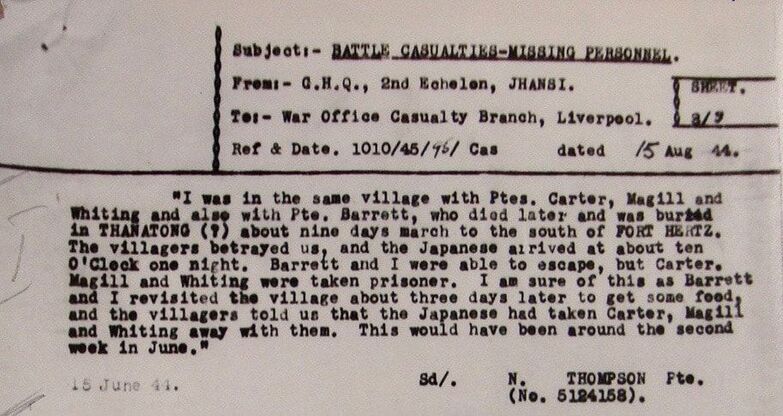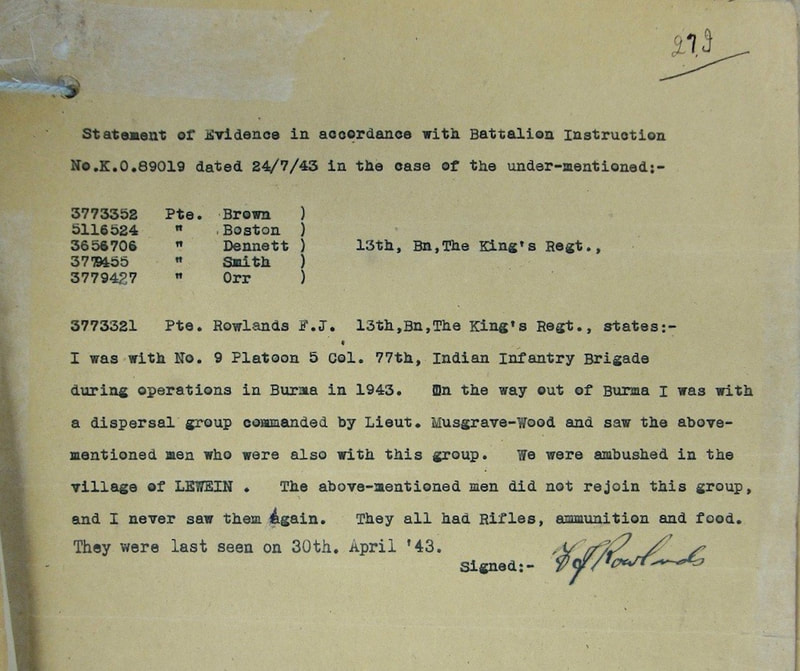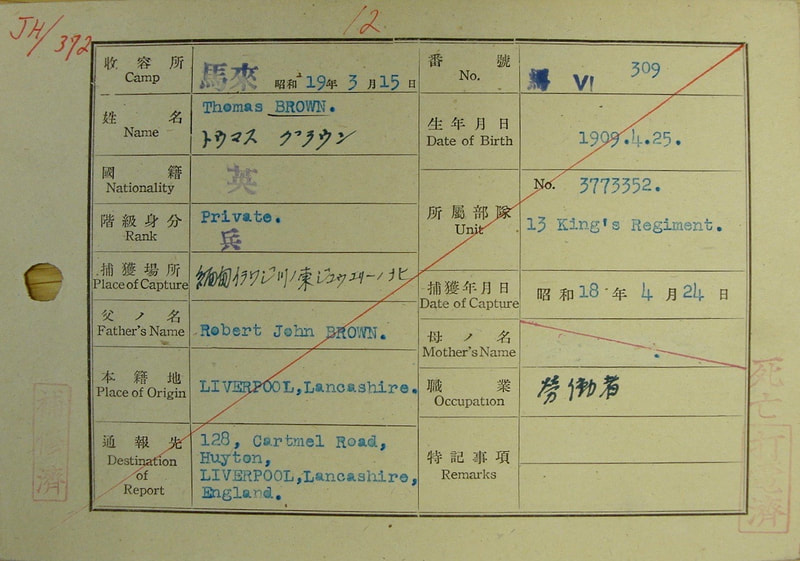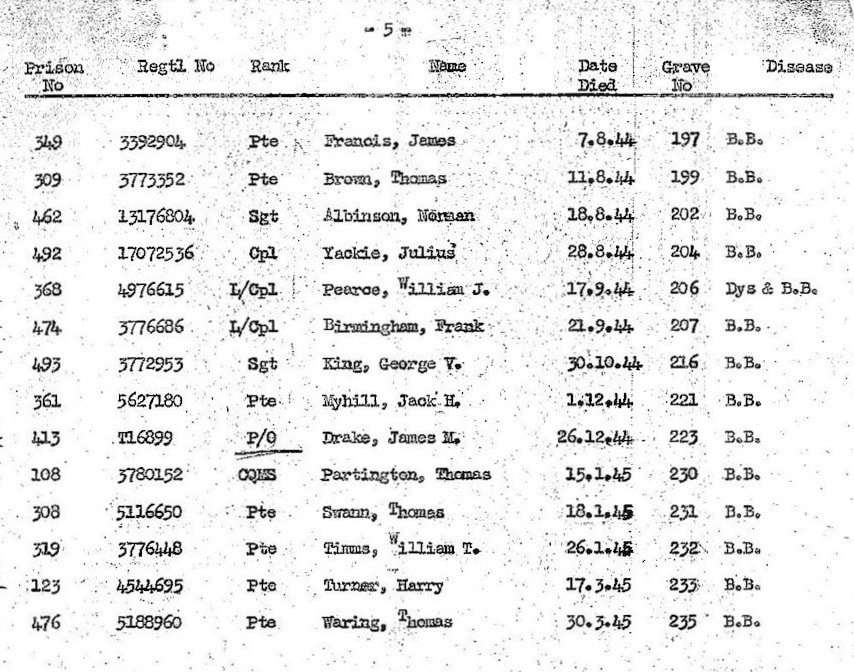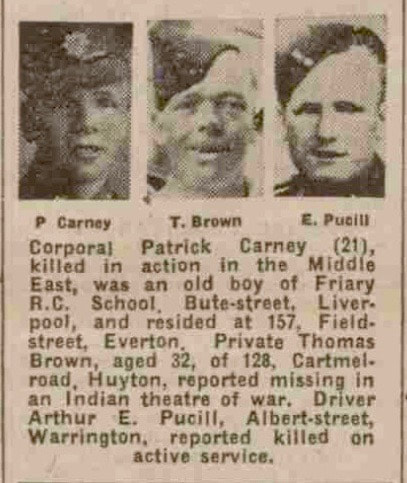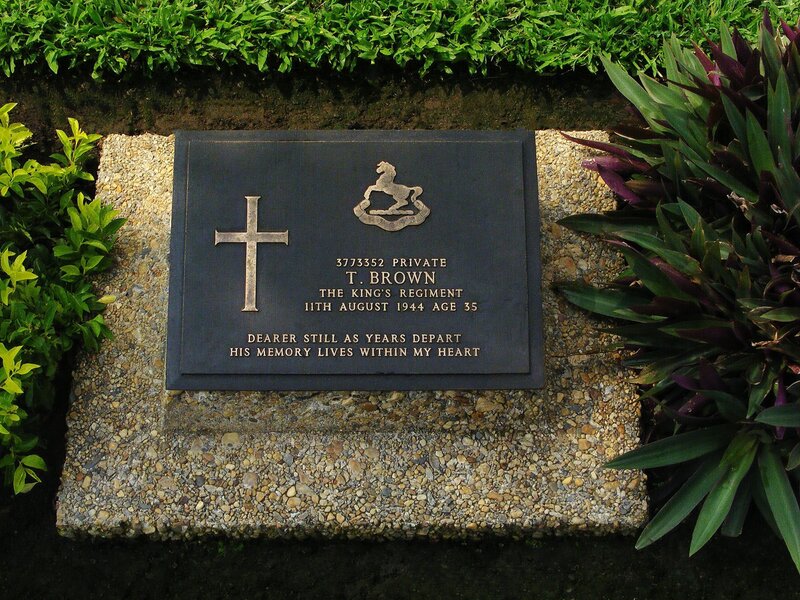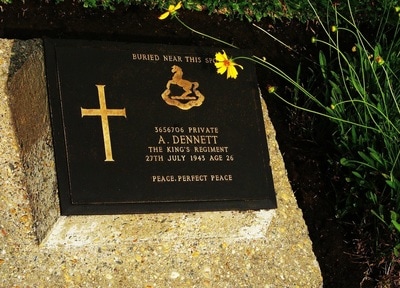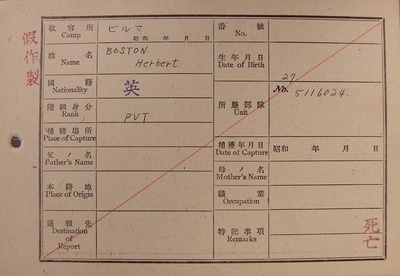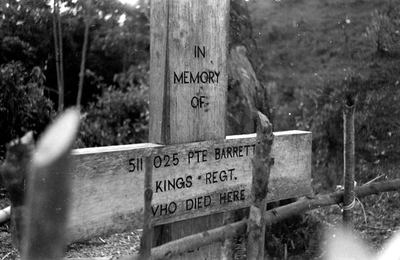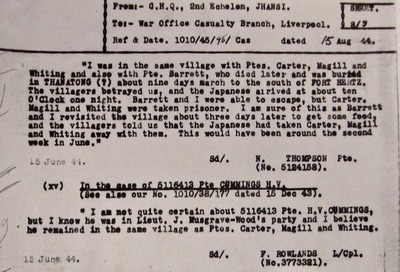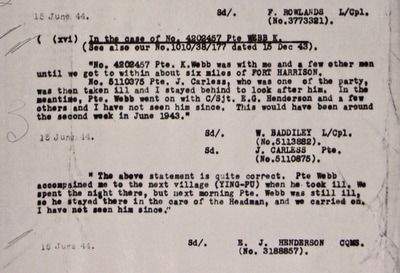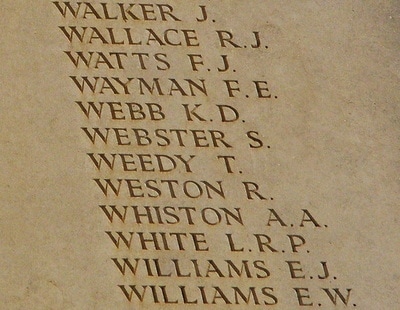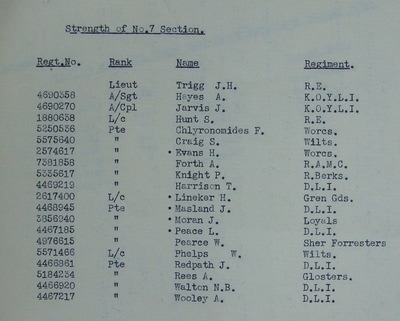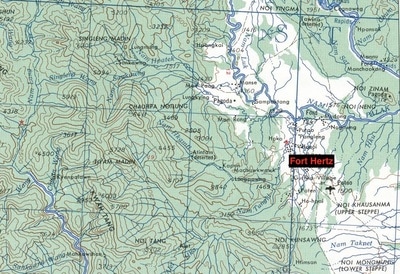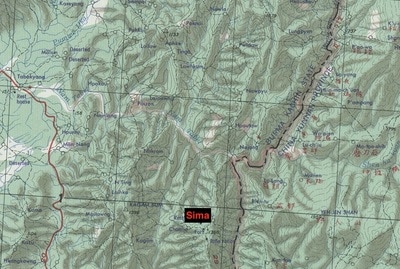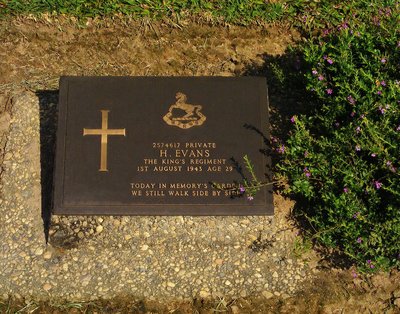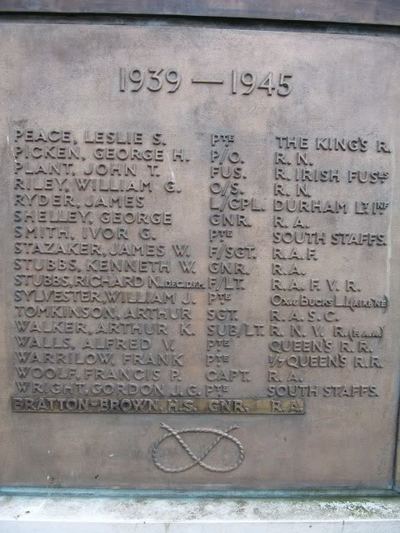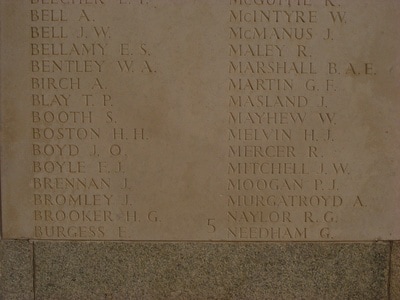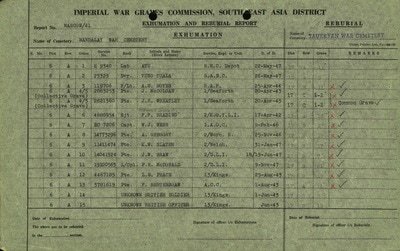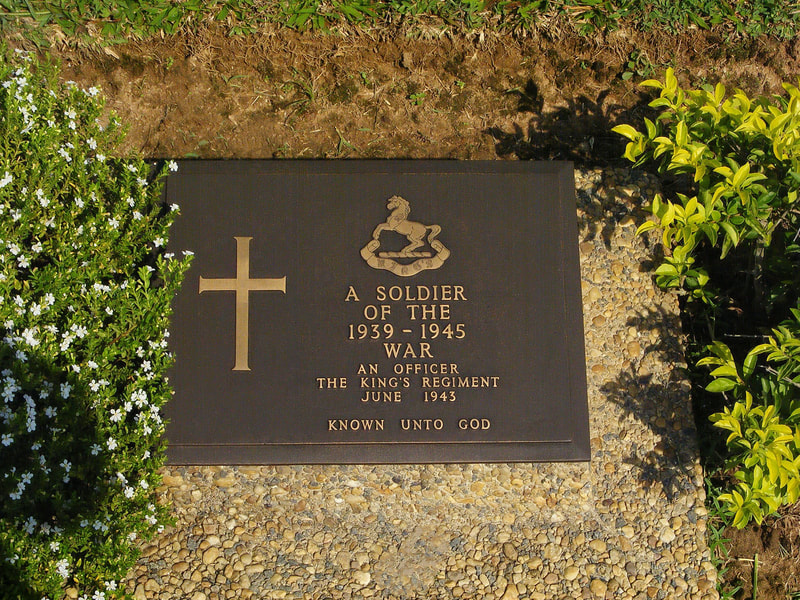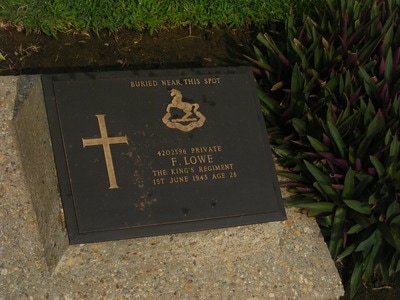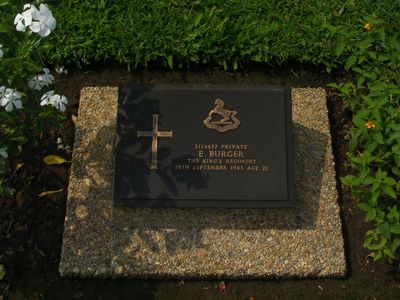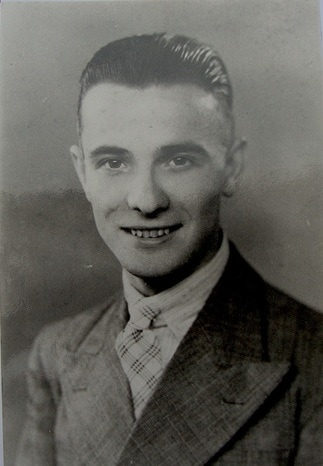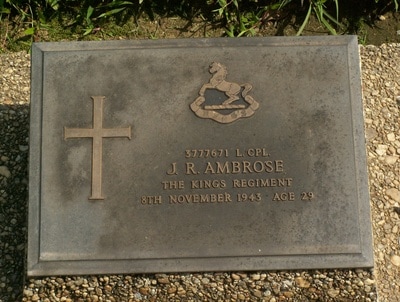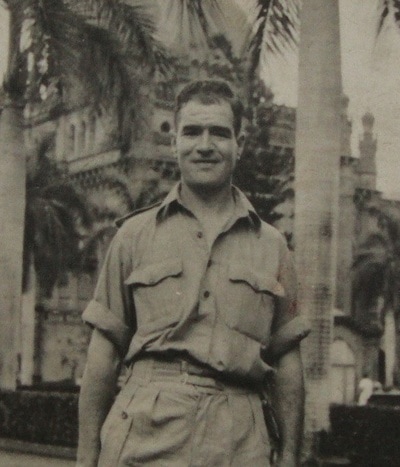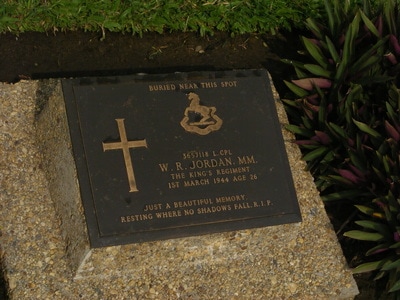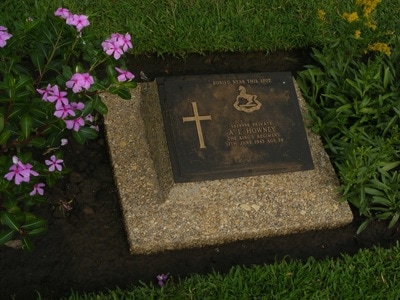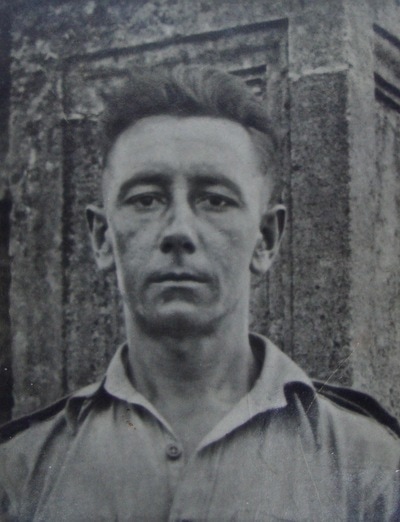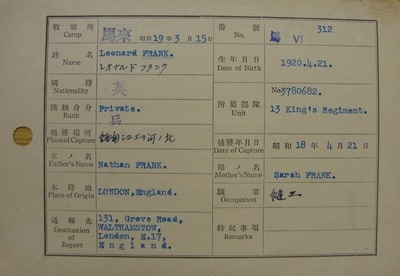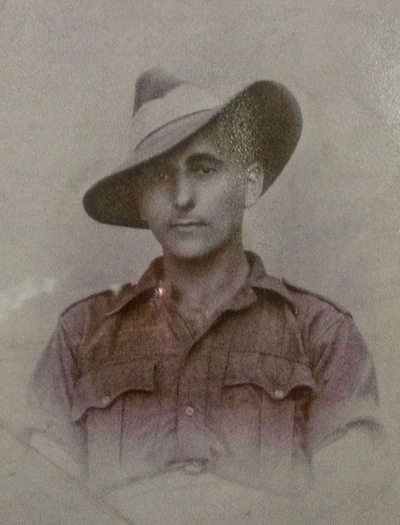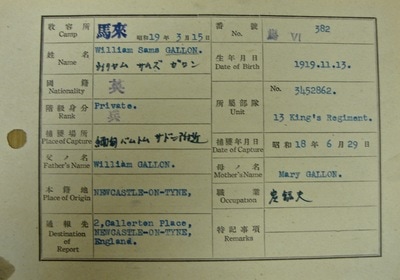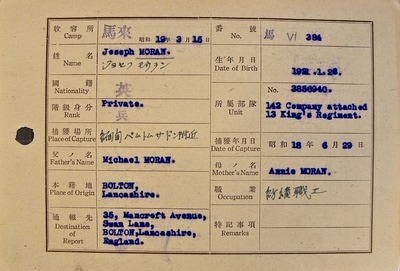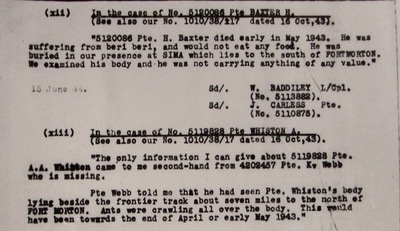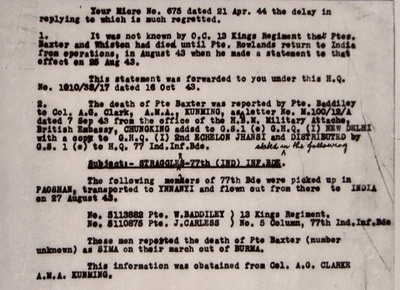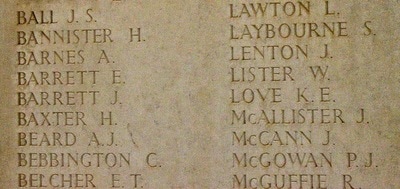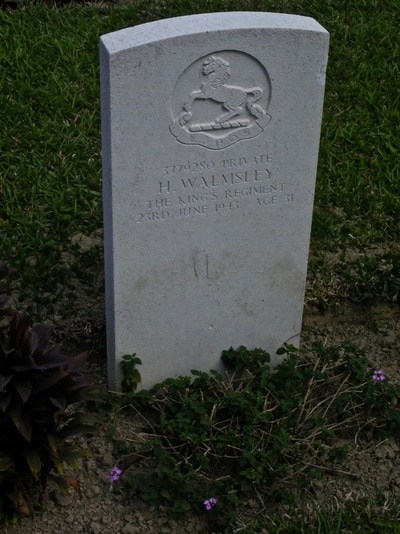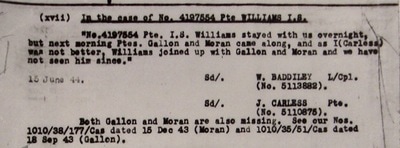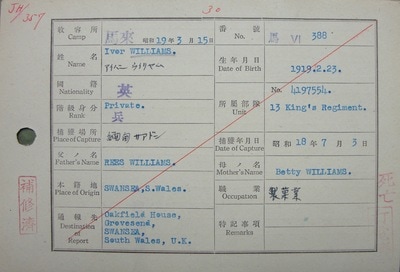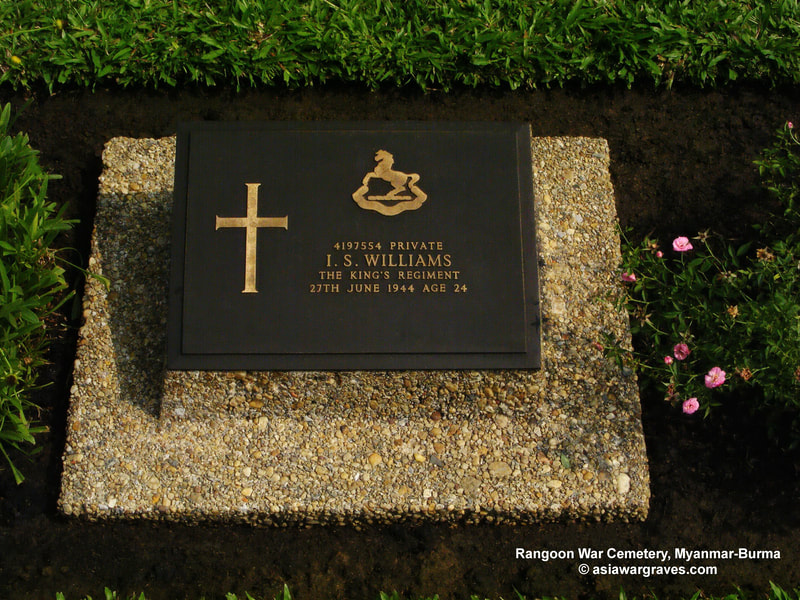Lieutenant John Musgrave-Wood
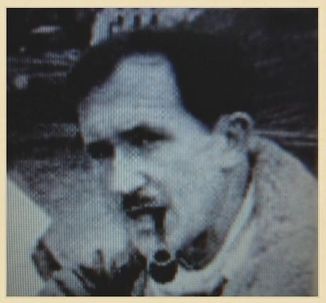 John Musgrave-Wood.
John Musgrave-Wood.
"Musgrave-Wood was an independent type and who liked running his own show, a frame of mind in which I had every sympathy."
(Brigadier Mike Calvert, from his book, Prisoners of Hope written in 1952).
John Bertram Musgrave-Wood was born on the 22nd February 1915 in the Yorkshire city of Leeds. The son of an artist and one of three brothers, John studied at the Leeds College of Art for just over a year before a wanderlust struck him and he signed up as a steward aboard a cruise liner and travelled the world.
At the outbreak of war in 1939, Musgrave-Wood enlisted as a Physical Training Instructor in the Duke of Cornwall's Light Infantry and was later commissioned into the Sherwood Forester's, with the Army number 176289. He was sent overseas to India, where in 1942 he volunteered for first Wingate expedition, joining Chindit training on the 6th November at the Atta Camp in the Central Provinces.
Lt. Musgrave-Wood was posted to 7 Column, under the overall command of Major Kenneth Gilkes, formerly of the North Staffordshire Regiment and took up a position in the Burma Rifles section within the column. During the early weeks of the expedition, 7 Column were often split up into sub-units, in order to perform the various tasks given over to them by Brigadier Wingate as the operation unfolded. This often resulted in officers such as Lt. Musgrave-Wood being left in temporary charge of large groups of men and away from the comfort and security of the main column strength.
Generally the column shadowed Wingate and his Brigade HQ, but once the order for dispersal was called in late March 1943, Gilkes decided to exit Burma via the Chinese borders and then attempting to hook back around to Fort Hertz, the most northerly place inside Burma still under Allied control. 7 Column had been fully re-fitted with new weapons, ammunition and uniforms in early April and had enjoyed another recent supply drop, where they stocked up heavily on rations. As they gathered on the banks of the Shweli River around the 10th April, Major Gilkes felt his men should have the means and wherewithal to make the longer, but hopefully safer journey out of Burma that year.
A few days earlier Gilkes had inherited over 100 men from 5 Column, who had been separated from their own unit after an ambush close to the Burmese village of Hintha. Major Gilkes took the ailing Chindits from 5 Column under his wing and divided them amongst his already pre-arranged dispersal groups. One of these dispersal parties, of roughly thirty-five men was led by Lt. Musgrave-Wood. Amongst this group was my own grandfather, who had also been separated from 5 Column after the ambush outside Hintha. Lt. Musgrave-Wood's dispersal group headed south, keeping the Shweli visible on their left hand side, until they reached the town of Myitson, here they turned sharply to the east where the river strikes out for the Chinese borders.
On the 14th April they found the river less formidable and finally crossed the Shweli near the village of Nayok (see map in the Gallery below). They shared this crossing with the dispersal party of Lieutenant Campbell-Paterson, formerly of the Royal Scots. Soon after the two dispersal parties had crossed the River Shweli at Nayok, they ran into enemy patrols and had to lie low in the surrounding scrub-jungle for several days. Finding food and water was becoming an issue for the now exhausted and desperate Chindits, the two groups realised that they would be better off apart and separated not long after. Lieutenant Campbell-Paterson's group did not fair well, with most of the men, including their leader, being captured by the Japanese within a few short days.
Nothing much is mentioned in books or diaries about the experiences of Lt. Musgrave-Wood's dispersal party after they had crossed the Shweli close to the village of Nayok. The group spent the next week or so moving around the area close to the villages of Lewein, Lonsa and Konkha (see map below). They managed to find food in these villages, but help was not given freely by the villagers, who now feared Japanese reprisals for aiding the British soldiers. During the last few days of April the party was bivouacked on the outskirts of Lewein when it was ambushed by a Japanese patrol and five men became separated from the main group. After the operation, information was given to the Army Investigation Bureau by Pte. F. J. Rowlands, who was a member of the dispersal party commanded by Lieutenant Musgrave-Wood in 1943:
I was with No. 9 Platoon in Column 5, 77th Indian Infantry Brigade during the operations in Burma in 1943. On the way out of Burma I was with a dispersal group commanded by Lieut. Musgrave-Wood and knew the following men : Ptes. Brown, Boston, Dennett, Smith and Orr. We were ambushed in the village of Lewein. These five men did not rejoin the group and I never saw them again. They all had rifles, ammunition and food. They were last seen on about the 30th April 1943.
NB. Pte. Rowlands was a member of the small party of men, led by Lieutenant Musgrave-Wood that reached the safety of Allied held territory in 1943. In fact of the original group present with the Lieutenant at the village of Lewein on the 30th April, only five made it back to India that year, with another three soldiers surviving just over two years in the hands of the Japanese as prisoners of war.
Pte. Leon Frank was also a member of the same dispersal party; he recalled the day the Japanese ambushed the Chindits at Lewein in his own private memoirs written after the war:
The order came from Wingate that we were to split up into small groups, so the column split up into platoon strength, approximately thirty men. I was with a group under a Lieutenant from the Sherwood Forrester's and we decided to make our way north to Fort Hertz which was still, of course, in British hands. The idea was that we would take some guides from a village, who would then guide us on to the next village and so on in stepping stones.
We were doing this successfully for a little while and then we had these two guides and what happened was this. lf you can imagine a mountain path going up. Imagine a cross leaning on its side and you're going up the centre of the cross which is a path and either side of the blank space is jungle. The top of the cross, the T of the cross, is a path going beyond at right angles. At this T across the top, as we were going up the path with jungle either side, the two Burmese guides who were leading us, one went left and one went right and disappeared into the jungle, whilst strolling across the T of the cross looking down on us was a Japanese patrol. We just melted into the jungle either side.
The Japanese had spotted us but we hoped if we were quiet enough they might go away. One or our chaps, one of the Dennett twins, and for no apparent reason because we already had this knowledge, shouted "Japs". That gave our position away and they started to open fire at us. We literally rolled down the hill. We didn't run, we just rolled or whatever to get to the bottom or the hill. We did everything we could to put our pursuers off the track. We crossed and re-crossed rivers. We could hear dogs in the distance. They used dogs to track us. Eventually we eluded them but we realised that the game was nearly up.
Leon Frank and his small group which included my own grandfather managed to elude the Japanese for another few days, before being captured at the village of Lonsa on the 12th May. To read more about this dispersal party, please click on the following link: Arthur Leslie Howney
To conclude this section of the story, shown below is a large Gallery of images relating to Lt. Musgrave-Wood and his experiences during the first Wingate expedition. These include several entries from relevant War diaries, a roll showing the men who made up his dispersal group and several witness statements, either written by Musgrave-Wood himself, or by the soldiers who escaped Burma alongside him. Please click on any image to bring it forward on the page.
(Brigadier Mike Calvert, from his book, Prisoners of Hope written in 1952).
John Bertram Musgrave-Wood was born on the 22nd February 1915 in the Yorkshire city of Leeds. The son of an artist and one of three brothers, John studied at the Leeds College of Art for just over a year before a wanderlust struck him and he signed up as a steward aboard a cruise liner and travelled the world.
At the outbreak of war in 1939, Musgrave-Wood enlisted as a Physical Training Instructor in the Duke of Cornwall's Light Infantry and was later commissioned into the Sherwood Forester's, with the Army number 176289. He was sent overseas to India, where in 1942 he volunteered for first Wingate expedition, joining Chindit training on the 6th November at the Atta Camp in the Central Provinces.
Lt. Musgrave-Wood was posted to 7 Column, under the overall command of Major Kenneth Gilkes, formerly of the North Staffordshire Regiment and took up a position in the Burma Rifles section within the column. During the early weeks of the expedition, 7 Column were often split up into sub-units, in order to perform the various tasks given over to them by Brigadier Wingate as the operation unfolded. This often resulted in officers such as Lt. Musgrave-Wood being left in temporary charge of large groups of men and away from the comfort and security of the main column strength.
Generally the column shadowed Wingate and his Brigade HQ, but once the order for dispersal was called in late March 1943, Gilkes decided to exit Burma via the Chinese borders and then attempting to hook back around to Fort Hertz, the most northerly place inside Burma still under Allied control. 7 Column had been fully re-fitted with new weapons, ammunition and uniforms in early April and had enjoyed another recent supply drop, where they stocked up heavily on rations. As they gathered on the banks of the Shweli River around the 10th April, Major Gilkes felt his men should have the means and wherewithal to make the longer, but hopefully safer journey out of Burma that year.
A few days earlier Gilkes had inherited over 100 men from 5 Column, who had been separated from their own unit after an ambush close to the Burmese village of Hintha. Major Gilkes took the ailing Chindits from 5 Column under his wing and divided them amongst his already pre-arranged dispersal groups. One of these dispersal parties, of roughly thirty-five men was led by Lt. Musgrave-Wood. Amongst this group was my own grandfather, who had also been separated from 5 Column after the ambush outside Hintha. Lt. Musgrave-Wood's dispersal group headed south, keeping the Shweli visible on their left hand side, until they reached the town of Myitson, here they turned sharply to the east where the river strikes out for the Chinese borders.
On the 14th April they found the river less formidable and finally crossed the Shweli near the village of Nayok (see map in the Gallery below). They shared this crossing with the dispersal party of Lieutenant Campbell-Paterson, formerly of the Royal Scots. Soon after the two dispersal parties had crossed the River Shweli at Nayok, they ran into enemy patrols and had to lie low in the surrounding scrub-jungle for several days. Finding food and water was becoming an issue for the now exhausted and desperate Chindits, the two groups realised that they would be better off apart and separated not long after. Lieutenant Campbell-Paterson's group did not fair well, with most of the men, including their leader, being captured by the Japanese within a few short days.
Nothing much is mentioned in books or diaries about the experiences of Lt. Musgrave-Wood's dispersal party after they had crossed the Shweli close to the village of Nayok. The group spent the next week or so moving around the area close to the villages of Lewein, Lonsa and Konkha (see map below). They managed to find food in these villages, but help was not given freely by the villagers, who now feared Japanese reprisals for aiding the British soldiers. During the last few days of April the party was bivouacked on the outskirts of Lewein when it was ambushed by a Japanese patrol and five men became separated from the main group. After the operation, information was given to the Army Investigation Bureau by Pte. F. J. Rowlands, who was a member of the dispersal party commanded by Lieutenant Musgrave-Wood in 1943:
I was with No. 9 Platoon in Column 5, 77th Indian Infantry Brigade during the operations in Burma in 1943. On the way out of Burma I was with a dispersal group commanded by Lieut. Musgrave-Wood and knew the following men : Ptes. Brown, Boston, Dennett, Smith and Orr. We were ambushed in the village of Lewein. These five men did not rejoin the group and I never saw them again. They all had rifles, ammunition and food. They were last seen on about the 30th April 1943.
NB. Pte. Rowlands was a member of the small party of men, led by Lieutenant Musgrave-Wood that reached the safety of Allied held territory in 1943. In fact of the original group present with the Lieutenant at the village of Lewein on the 30th April, only five made it back to India that year, with another three soldiers surviving just over two years in the hands of the Japanese as prisoners of war.
Pte. Leon Frank was also a member of the same dispersal party; he recalled the day the Japanese ambushed the Chindits at Lewein in his own private memoirs written after the war:
The order came from Wingate that we were to split up into small groups, so the column split up into platoon strength, approximately thirty men. I was with a group under a Lieutenant from the Sherwood Forrester's and we decided to make our way north to Fort Hertz which was still, of course, in British hands. The idea was that we would take some guides from a village, who would then guide us on to the next village and so on in stepping stones.
We were doing this successfully for a little while and then we had these two guides and what happened was this. lf you can imagine a mountain path going up. Imagine a cross leaning on its side and you're going up the centre of the cross which is a path and either side of the blank space is jungle. The top of the cross, the T of the cross, is a path going beyond at right angles. At this T across the top, as we were going up the path with jungle either side, the two Burmese guides who were leading us, one went left and one went right and disappeared into the jungle, whilst strolling across the T of the cross looking down on us was a Japanese patrol. We just melted into the jungle either side.
The Japanese had spotted us but we hoped if we were quiet enough they might go away. One or our chaps, one of the Dennett twins, and for no apparent reason because we already had this knowledge, shouted "Japs". That gave our position away and they started to open fire at us. We literally rolled down the hill. We didn't run, we just rolled or whatever to get to the bottom or the hill. We did everything we could to put our pursuers off the track. We crossed and re-crossed rivers. We could hear dogs in the distance. They used dogs to track us. Eventually we eluded them but we realised that the game was nearly up.
Leon Frank and his small group which included my own grandfather managed to elude the Japanese for another few days, before being captured at the village of Lonsa on the 12th May. To read more about this dispersal party, please click on the following link: Arthur Leslie Howney
To conclude this section of the story, shown below is a large Gallery of images relating to Lt. Musgrave-Wood and his experiences during the first Wingate expedition. These include several entries from relevant War diaries, a roll showing the men who made up his dispersal group and several witness statements, either written by Musgrave-Wood himself, or by the soldiers who escaped Burma alongside him. Please click on any image to bring it forward on the page.
On his return to India after Operation Longcloth, Lt. Musgrave-Wood was hospitalised for a short time before re-joining the 13th King's at the Napier Army Barracks in Karachi. On the 13th September 1943, he was posted over to the 2nd Burma Rifles, however, he did not take up his position with the battalion, who were then based at Jhansi, until the 13th November. After their much praised performance during the first Chindit expedition, it was natural that the 2nd Burma Rifles would form an integral part of the second campaign. John Musgrave-Wood was attached to the Lancashire Fusiliers, which provided two columns for Mike Calvert's 77th Brigade. He served with 50 Column as commander of a Special Detachment, with orders to liaise with the local Kachin Levies in the area around Mawlu (White City) and to form a secret base from which to organise raids against the Japanese.
NB. 50 Column were led by Lt-Colonel Hugh Christie in 1944.
From the book, Prisoners of Hope, written by Mike Calvert in 1952:
Everywhere in the hills around Mawlu, we found evidence of Musgrave-Wood's invaluable work with the Kachins. We passed close to his lair at Naman in late April 1944, when we moved through the village of Tengaw as we marched north towards Mogaung. I had a long interview with Musgrave-Wood sometime later. He and his Burma Rifles, with a few British troops alongside, wireless operators etc., were very keen to remain with the Kachins. They had worked it out and considered that they could stay there all through the monsoon.
They had run a very good information service for over six weeks and had raised, armed and trained the Gangaw Levies. Twice the Japs had tried to eradicate him (Musgrave-Wood), but never found his cleverly concealed hideout. If they had, they would not have been too happy, as he had put down every sort of booby-trap device and thoughtfully sited mortar and machine gun positions.
In late 1944, John Musgrave-Wood, along with another Chindit soldier, Major Patrick Boyle compiled the amusingly entitled book, Jungle Jungle Little Chindit. This was a collection of Chindit related anecdotes and poems inspired by their experiences during the two Wingate operations, in conjunction with some wonderful sketches and cartoons drawn by Musgrave-Wood himself.
From the Yorkshire Post and Leeds Mercury, dated Thursday 28th February 1946:
For the Chindits
Servicemen who fought in Burma will find much to entertain them in the book, Jungle, Jungle, Little Chindit, by Major Patrick Boyle and Major Jon Musgrave-Wood, which is published today by Hollis and Carter, price 12s.6d. The design on the jacket shows a couple of forlorn looking veterans, sitting under a tree in the heart of the jungle while tropical rain streams down. One says to the other: When this is all over I suppose some ape will write a book about it and try and make out it was funny!
Well, here is the book, and it is certainly funny. This is especially true of the illustrations. Not long ago I saw in Leeds a film called Burma Victory, which gives, I am assured, a true picture of that miraculous campaign. What impressed me more than anything else were the scenes depicting night in the impenetrable jungle. The howling of wild animals heard far off, the croaking of frogs, the humming of countless insects and the cries of the Japanese, trying to persuade our men to give away their positions, all combined to create an atmosphere of inescapable horror. And something of that atmosphere invades the light-heartedness of these lines found at the end of a chapter from the book:
NB. 50 Column were led by Lt-Colonel Hugh Christie in 1944.
From the book, Prisoners of Hope, written by Mike Calvert in 1952:
Everywhere in the hills around Mawlu, we found evidence of Musgrave-Wood's invaluable work with the Kachins. We passed close to his lair at Naman in late April 1944, when we moved through the village of Tengaw as we marched north towards Mogaung. I had a long interview with Musgrave-Wood sometime later. He and his Burma Rifles, with a few British troops alongside, wireless operators etc., were very keen to remain with the Kachins. They had worked it out and considered that they could stay there all through the monsoon.
They had run a very good information service for over six weeks and had raised, armed and trained the Gangaw Levies. Twice the Japs had tried to eradicate him (Musgrave-Wood), but never found his cleverly concealed hideout. If they had, they would not have been too happy, as he had put down every sort of booby-trap device and thoughtfully sited mortar and machine gun positions.
In late 1944, John Musgrave-Wood, along with another Chindit soldier, Major Patrick Boyle compiled the amusingly entitled book, Jungle Jungle Little Chindit. This was a collection of Chindit related anecdotes and poems inspired by their experiences during the two Wingate operations, in conjunction with some wonderful sketches and cartoons drawn by Musgrave-Wood himself.
From the Yorkshire Post and Leeds Mercury, dated Thursday 28th February 1946:
For the Chindits
Servicemen who fought in Burma will find much to entertain them in the book, Jungle, Jungle, Little Chindit, by Major Patrick Boyle and Major Jon Musgrave-Wood, which is published today by Hollis and Carter, price 12s.6d. The design on the jacket shows a couple of forlorn looking veterans, sitting under a tree in the heart of the jungle while tropical rain streams down. One says to the other: When this is all over I suppose some ape will write a book about it and try and make out it was funny!
Well, here is the book, and it is certainly funny. This is especially true of the illustrations. Not long ago I saw in Leeds a film called Burma Victory, which gives, I am assured, a true picture of that miraculous campaign. What impressed me more than anything else were the scenes depicting night in the impenetrable jungle. The howling of wild animals heard far off, the croaking of frogs, the humming of countless insects and the cries of the Japanese, trying to persuade our men to give away their positions, all combined to create an atmosphere of inescapable horror. And something of that atmosphere invades the light-heartedness of these lines found at the end of a chapter from the book:
When the night comes down over Burma
And the velvet shadows enfold
The depths of the pillared forest
And the air grows still and cold;
Lay you down to slumber
And ere you fall asleep.
Hark to the sigh of the tree tops
And the myriad crickets cheep.
Softly dream, young soldier
Of life and its sweeter fruits
But always hang on to your rifle
And never get out of your boots.
And the velvet shadows enfold
The depths of the pillared forest
And the air grows still and cold;
Lay you down to slumber
And ere you fall asleep.
Hark to the sigh of the tree tops
And the myriad crickets cheep.
Softly dream, young soldier
Of life and its sweeter fruits
But always hang on to your rifle
And never get out of your boots.
After the war, John returned to art school, studying painting at Goldsmith's College in London. In 1948, he submitted many colourful caricatures for the publication, Tatler and Bystander under the pseudonym of Emmwood and enjoyed a long and successful career as a cartoonist, with his artwork appearing in many of the well-known British tabloids over many years. For the last quarter of his life, John Bertram Musgrave-Wood lived in the village of Vallabrix in Provence, France. He died there on the 30th August 1999.
To view some of his more satirical and politically motivated cartoons, please click on the following link:
www.original-political-cartoon.com/cartoon-gallery/artists/emmwood-john-musgrave-wood-1915-1999/
Seen below is another Gallery of images in relation to this story. Please click on any image to bring it forward on the page.
To view some of his more satirical and politically motivated cartoons, please click on the following link:
www.original-political-cartoon.com/cartoon-gallery/artists/emmwood-john-musgrave-wood-1915-1999/
Seen below is another Gallery of images in relation to this story. Please click on any image to bring it forward on the page.
To conclude this narrative, I thought we should investigate the fate of the thirty or so men that made up Lt. Musgrave-Wood's dispersal party back in 1943. Here, in no particular order, is what I know about these men.
3656706 Pte. Arthur Dennett. A soldier with 5 Column, he was last seen after the ambush at Lewein on 30th April 1943. Sadly, Arthur died inside Block 6 of Rangoon Jail on the 27th July 1943, with the POW number 431. According to his POW index card, Arthur died from exhaustion and the complications to his health caused by the disease of beri beri. He was originally buried in the English Cantonment Cemetery situated in the eastern sector of the city, close to the Royal Lakes. After the war, the Imperial Graves Commission moved all the burials from this cemetery over to the newly constructed Rangoon War Cemetery. To read more about Arthur Dennett and his time on Operation Longcloth, please click on the following link: The Dennett Twins
3779455 Pte. William Smith. Another soldier with 5 Column, he was last seen at Lewein on the 30th April 1943. William sadly died inside Block 6 of Rangoon Jail on the 4th October 1943. William was given the POW number 425 and like all other prisoners, had to recite this number in Japanese at the morning and evening roll calls. Pte. Smith was an original member of the 13th King's that travelled to India aboard the troopship 'Oronsay' on the 8th December 1941. Unfortunately, there are no other details in relation to his sad demise inside Rangoon Jail, although we do know that he was also buried at the English Cantonment Cemetery, before being re-interred at Rangoon War Cemetery after the war.
5116524 Pte. Herbert Horatio Boston. Also a soldier with 5 Column, he was last seen at Lewein on the 30th April 1943. Herbert died inside Block 6 of Rangoon Jail on the 7th August 1943, also suffering from the effects of the disease beri beri. Herbert, who was issued with the POW number 524, was from Heath Hayes in Staffordshire and was originally enlisted into the Royal Warwickshire Regiment, before being transferred to the 13th King's on the 26th September 1942. Although he perished in Block 6 of the prison, Herbert does not have a memorial grave plaque in Rangoon War Cemetery. He is remembered instead upon Face 5 of the Rangoon Memorial at Taukkyan War Cemetery, situated on the northern outskirts of the city. It is possible that he was buried alongside his Chindit comrades in the English Cantonment Cemetery, but that any details for the location of his grave were lost and so his remains could not be accurately identified.
3779427 Pte. William Henry Orr. A muleteer with 5 Column on Operation Longcloth, William, from Edge Hill in Liverpool, was last seen on the 1st May 1943, when he was reportedly attempting to re-join the main body of 7 Column led by Major Gilkes. Around that time he had been complaining of heart pain, although his actual cause of death is still unknown. William was never seen or heard of again and is remembered upon Face 6 of the Rangoon Memorial.
Pte. 5119025 Edward Barrett was born during the spring of 1915 in Salford, a borough which makes up part of Greater Manchester. Edward was a member of 5 Column on Operation Longcloth, but was formerly a soldier with the Royal Warwickshire Regiment and was posted to the 13th King's after arriving in India during the late summer of 1942. He joined Chindit training at the Saugor Camp on the 26th September.
According to the missing in action listings for 5 Column in 1943, Pte. Barrett was reported missing as of the 5th April 1943. Alongside his entry on the roll it states: Died at Htingnan on 27/07/1943. This would suggest that he had remained with Musgrave-Wood, almost throughout the Lieutenant's march north through the Kachin/Yunnan Borders in the hope of reaching the British outpost of Fort Hertz. To read more about Edward Barrett and his time on Operation Longcloth, please click on the following link: Pte. Edward Barrett
3656706 Pte. Arthur Dennett. A soldier with 5 Column, he was last seen after the ambush at Lewein on 30th April 1943. Sadly, Arthur died inside Block 6 of Rangoon Jail on the 27th July 1943, with the POW number 431. According to his POW index card, Arthur died from exhaustion and the complications to his health caused by the disease of beri beri. He was originally buried in the English Cantonment Cemetery situated in the eastern sector of the city, close to the Royal Lakes. After the war, the Imperial Graves Commission moved all the burials from this cemetery over to the newly constructed Rangoon War Cemetery. To read more about Arthur Dennett and his time on Operation Longcloth, please click on the following link: The Dennett Twins
3779455 Pte. William Smith. Another soldier with 5 Column, he was last seen at Lewein on the 30th April 1943. William sadly died inside Block 6 of Rangoon Jail on the 4th October 1943. William was given the POW number 425 and like all other prisoners, had to recite this number in Japanese at the morning and evening roll calls. Pte. Smith was an original member of the 13th King's that travelled to India aboard the troopship 'Oronsay' on the 8th December 1941. Unfortunately, there are no other details in relation to his sad demise inside Rangoon Jail, although we do know that he was also buried at the English Cantonment Cemetery, before being re-interred at Rangoon War Cemetery after the war.
5116524 Pte. Herbert Horatio Boston. Also a soldier with 5 Column, he was last seen at Lewein on the 30th April 1943. Herbert died inside Block 6 of Rangoon Jail on the 7th August 1943, also suffering from the effects of the disease beri beri. Herbert, who was issued with the POW number 524, was from Heath Hayes in Staffordshire and was originally enlisted into the Royal Warwickshire Regiment, before being transferred to the 13th King's on the 26th September 1942. Although he perished in Block 6 of the prison, Herbert does not have a memorial grave plaque in Rangoon War Cemetery. He is remembered instead upon Face 5 of the Rangoon Memorial at Taukkyan War Cemetery, situated on the northern outskirts of the city. It is possible that he was buried alongside his Chindit comrades in the English Cantonment Cemetery, but that any details for the location of his grave were lost and so his remains could not be accurately identified.
3779427 Pte. William Henry Orr. A muleteer with 5 Column on Operation Longcloth, William, from Edge Hill in Liverpool, was last seen on the 1st May 1943, when he was reportedly attempting to re-join the main body of 7 Column led by Major Gilkes. Around that time he had been complaining of heart pain, although his actual cause of death is still unknown. William was never seen or heard of again and is remembered upon Face 6 of the Rangoon Memorial.
Pte. 5119025 Edward Barrett was born during the spring of 1915 in Salford, a borough which makes up part of Greater Manchester. Edward was a member of 5 Column on Operation Longcloth, but was formerly a soldier with the Royal Warwickshire Regiment and was posted to the 13th King's after arriving in India during the late summer of 1942. He joined Chindit training at the Saugor Camp on the 26th September.
According to the missing in action listings for 5 Column in 1943, Pte. Barrett was reported missing as of the 5th April 1943. Alongside his entry on the roll it states: Died at Htingnan on 27/07/1943. This would suggest that he had remained with Musgrave-Wood, almost throughout the Lieutenant's march north through the Kachin/Yunnan Borders in the hope of reaching the British outpost of Fort Hertz. To read more about Edward Barrett and his time on Operation Longcloth, please click on the following link: Pte. Edward Barrett
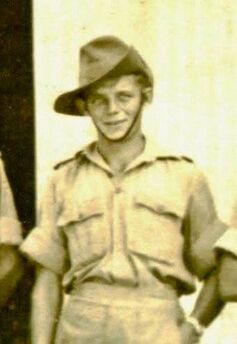 Pte. Noel 'Sailor' Thompson.
Pte. Noel 'Sailor' Thompson.
5124158 Pte. Noel Thompson was a soldier with 5 Column on the first Chindit expedition. He was one of the few survivors from the dispersal party led by Lt. Musgrave-Wood and succeeded in reaching Fort Hertz in July 1943. Pte. Thompson gave a witness statement after the operation in regards to the undermentioned Ptes. Carter, Magill and Whiting. He was also with Edward Barrett for a time in mid-June, as the group were moving north towards Fort Hertz. His witness statement can be viewed below.
Update 04/12/2018
From the pages of Beyond the Chindwin, by Bernard Fergusson.
At the Saugor camp we trained from six in the morning until two in the afternoon. The country was fresh and had much more variety than the old area. We concentrated on the crossing of rivers and became expert at getting ropes over and slinging stores across. Most delightful of all was the swimming. I held two bathing parades a day and succeeded in turning many non-nants into fair nants. I had two particularly good swimmers, Sailor Thompson, a Lowestoft fisherman, so called to distinguish him from two other namesakes and a young lad called Berger, always in trouble and always lazy, except when it was a question of watermanship training, when he was tireless. These two between them taught over a dozen men to swim who could not previously swim a stroke. There was a third, Pte. Lancaster, not in the same class as they, but, as so often happens, an even better teacher.
On the 21st November 2018, Peter Thompson, the son of Noel Thompson made contact with the Chindit Society:
My father was in the first Chindit expedition, his name was Pte. Noel Thompson 5124158 (Sailor Thompson, because he came from Lowestoft) and was one of the younger members of the Brigade. This is because he lied about his age when he joined the Army in 28th January 1941 at the age of 16 and put his place of birth as Great Yarmouth, we only found this out after his death. He originally joined the Royal Warwickshire’s and was shipped out to India 27th July 1942 and was transferred to the King's on the 20th September 1942.
I am not sure which column he was in, it was either the 5th or 7th Column. What we do know is that his column received the order to scatter when attacked by a larger Jap force and he and several others set off for India via China, but he was the only one from his group to survive the ordeal. He left a hand written manuscript describing his ordeal which I plan to type and pass copies to the family, but due to pressure of work, this probably not take place until some time next year. I would be pleased to let the Society have a copy when it is completed.
What I also know, is that I was named after his best mate, who died just as they reached India, I only know his first name (Peter) and I suspect he came from Lancashire. It would be wonderful if I could find out his full name and where he came from. I would appreciate it if you have any information you could let me have about him, so I can put this in the preface and pass it on to the family.
Many thanks in anticipation, Peter Noel Thompson.
I replied:
Dear Peter, I can tell you that your father Noel Thompson was in 5 Column on Operation Longcloth, commanded by Major Bernard Fergusson. Fergusson mentions your father three times in his book, Beyond the Chindwin. In the book, he confirms that Sailor Thompson was from Lowestoft and was a vital part of his unit, teaching many of the other soldiers how swim during training. If you have not done so already, I recommend reading a copy of Bernard Fergusson's book, it should be fairly straightforward to find a copy on Amazon.
Later on, when 5 Column crossed the Chindwin River and entered Burma, your father proved indispensable once again when the power rope the column were using to cross the river became snagged on the bottom. It was your father who dived down and untangled the rope, allowing the column to get across safely. As you seem to know already, Sailor Thompson was separated from 5 Column later during the operation. This was on around the 29th March after the column had been ambushed by the Japanese outside a village called Hintha. One hundred men from No. 5 Column were detached and were fortunate to bump into No. 7 Column a few days later. The commander of 7 Column, Major Gilkes divided these lost men into his dispersal groups as they prepared to cross the Shweli River and head for China.
Your father and around 30 others, including my own grandfather all went on with Lieutenant Musgrave-Wood and decided to head for a place called Fort Hertz in northern Burma. Many men never completed this journey and either died along the way, or were captured by the Japanese. Sailor Thompson was the only survivor from a small group of five men, including Edward Barrett from Salford, Samuel Carter from near Preston, Charles Whiting from near Manchester and James Magill from Calder Vale in Lancashire.
After reaching India, your father supplied the Army with a written statement concerning the fate of the above mentioned men. I have attached this to the email for you to read. In my list of Longcloth soldiers, I had not made the connection with Sailor Thompson being the same man as Pte. Noel Thompson. So in the Musgrave-Wood story I place him as being originally from 7 Column and not 5 Column, this has now been corrected. I also cannot connect a soldier with the first name Peter as being with your father on their journey out of Burma. There are several men with that Christian name, but only two perished trying to exit Burma in 1943. I will send you their details if you would like them.
The Chindit Society would very much like to have copy of your father's manuscript when you are ready. In the meantime, do you have a photograph of Noel that you can scan and send over please. It is always a wonderful moment in my research when I get to see a photograph of a Longcloth Chindit for the first time. I look forward to hearing from you soon and thank you for making contact.
Best wishes, Steve Fogden (Chindit Society Archivist).
Peter replied:
Steve, many, many thanks for the information you sent, I am now starting to fill in some of the gaps in my father’s Army life. I do remember as a boy, he told me that once he and some others were in a village in Burma when the Japs ambushed them and he had to punch a Jap soldier to get away. It would seem now that was the village where they were ultimately betrayed and a number of them were captured. It is my intention to read through the manuscript again over the next few weeks and try to glean a little more information, the last time I read it was about 20 years ago. I will let you know if I find anything of interest. When it is typed up, I will gladly let you have a copy. Once again, many thanks for the information and please accept my apologies for not responding earlier. Best wishes, Peter.
Seen below is the witness statement given by Noel Thompson on the 15th June 1944, in relation to the last known whereabouts of Ptes. Carter, Barrett, Magill and Whiting on the journey out of Burma in May 1943.
Update 04/12/2018
From the pages of Beyond the Chindwin, by Bernard Fergusson.
At the Saugor camp we trained from six in the morning until two in the afternoon. The country was fresh and had much more variety than the old area. We concentrated on the crossing of rivers and became expert at getting ropes over and slinging stores across. Most delightful of all was the swimming. I held two bathing parades a day and succeeded in turning many non-nants into fair nants. I had two particularly good swimmers, Sailor Thompson, a Lowestoft fisherman, so called to distinguish him from two other namesakes and a young lad called Berger, always in trouble and always lazy, except when it was a question of watermanship training, when he was tireless. These two between them taught over a dozen men to swim who could not previously swim a stroke. There was a third, Pte. Lancaster, not in the same class as they, but, as so often happens, an even better teacher.
On the 21st November 2018, Peter Thompson, the son of Noel Thompson made contact with the Chindit Society:
My father was in the first Chindit expedition, his name was Pte. Noel Thompson 5124158 (Sailor Thompson, because he came from Lowestoft) and was one of the younger members of the Brigade. This is because he lied about his age when he joined the Army in 28th January 1941 at the age of 16 and put his place of birth as Great Yarmouth, we only found this out after his death. He originally joined the Royal Warwickshire’s and was shipped out to India 27th July 1942 and was transferred to the King's on the 20th September 1942.
I am not sure which column he was in, it was either the 5th or 7th Column. What we do know is that his column received the order to scatter when attacked by a larger Jap force and he and several others set off for India via China, but he was the only one from his group to survive the ordeal. He left a hand written manuscript describing his ordeal which I plan to type and pass copies to the family, but due to pressure of work, this probably not take place until some time next year. I would be pleased to let the Society have a copy when it is completed.
What I also know, is that I was named after his best mate, who died just as they reached India, I only know his first name (Peter) and I suspect he came from Lancashire. It would be wonderful if I could find out his full name and where he came from. I would appreciate it if you have any information you could let me have about him, so I can put this in the preface and pass it on to the family.
Many thanks in anticipation, Peter Noel Thompson.
I replied:
Dear Peter, I can tell you that your father Noel Thompson was in 5 Column on Operation Longcloth, commanded by Major Bernard Fergusson. Fergusson mentions your father three times in his book, Beyond the Chindwin. In the book, he confirms that Sailor Thompson was from Lowestoft and was a vital part of his unit, teaching many of the other soldiers how swim during training. If you have not done so already, I recommend reading a copy of Bernard Fergusson's book, it should be fairly straightforward to find a copy on Amazon.
Later on, when 5 Column crossed the Chindwin River and entered Burma, your father proved indispensable once again when the power rope the column were using to cross the river became snagged on the bottom. It was your father who dived down and untangled the rope, allowing the column to get across safely. As you seem to know already, Sailor Thompson was separated from 5 Column later during the operation. This was on around the 29th March after the column had been ambushed by the Japanese outside a village called Hintha. One hundred men from No. 5 Column were detached and were fortunate to bump into No. 7 Column a few days later. The commander of 7 Column, Major Gilkes divided these lost men into his dispersal groups as they prepared to cross the Shweli River and head for China.
Your father and around 30 others, including my own grandfather all went on with Lieutenant Musgrave-Wood and decided to head for a place called Fort Hertz in northern Burma. Many men never completed this journey and either died along the way, or were captured by the Japanese. Sailor Thompson was the only survivor from a small group of five men, including Edward Barrett from Salford, Samuel Carter from near Preston, Charles Whiting from near Manchester and James Magill from Calder Vale in Lancashire.
After reaching India, your father supplied the Army with a written statement concerning the fate of the above mentioned men. I have attached this to the email for you to read. In my list of Longcloth soldiers, I had not made the connection with Sailor Thompson being the same man as Pte. Noel Thompson. So in the Musgrave-Wood story I place him as being originally from 7 Column and not 5 Column, this has now been corrected. I also cannot connect a soldier with the first name Peter as being with your father on their journey out of Burma. There are several men with that Christian name, but only two perished trying to exit Burma in 1943. I will send you their details if you would like them.
The Chindit Society would very much like to have copy of your father's manuscript when you are ready. In the meantime, do you have a photograph of Noel that you can scan and send over please. It is always a wonderful moment in my research when I get to see a photograph of a Longcloth Chindit for the first time. I look forward to hearing from you soon and thank you for making contact.
Best wishes, Steve Fogden (Chindit Society Archivist).
Peter replied:
Steve, many, many thanks for the information you sent, I am now starting to fill in some of the gaps in my father’s Army life. I do remember as a boy, he told me that once he and some others were in a village in Burma when the Japs ambushed them and he had to punch a Jap soldier to get away. It would seem now that was the village where they were ultimately betrayed and a number of them were captured. It is my intention to read through the manuscript again over the next few weeks and try to glean a little more information, the last time I read it was about 20 years ago. I will let you know if I find anything of interest. When it is typed up, I will gladly let you have a copy. Once again, many thanks for the information and please accept my apologies for not responding earlier. Best wishes, Peter.
Seen below is the witness statement given by Noel Thompson on the 15th June 1944, in relation to the last known whereabouts of Ptes. Carter, Barrett, Magill and Whiting on the journey out of Burma in May 1943.
3779379 Pte. Samuel Carter was with Ptes. Magill and Whiting at a village where the Headman had promised to keep them safe. It is suggested that the Headman betrayed them to the Japanese and they were taken prisoner. Judging by the recorded date of death for Pte. Carter, 11th May 1943, it seems likely that he resisted his capture and was killed at the village. Samuel, another soldier from 5 Column, was the son of Charles Henry and Margaret Ellen Carter and the husband of Ada Carter, from Ashton-on-Ribble, a suburb of Preston in Lancashire. He is remembered upon Face 5 of the Rangoon Memorial.
3781471 Pte. James Magill was the husband of Jane Agnes Magill, from Calder Vale in Lancashire. Originally a member of 5 Column, he was captured at the same village mentioned above and was eventually sent down to Rangoon Central Jail. Sadly, James perished inside Block 6 of the jail on the 6th September 1943 and was buried originally at the English Cantonment Cemetery, before being moved to Rangoon War Cemetery after the war. James was given the POW number 582 at Rangoon and was recorded as being buried in grave no. 51 at the Cantonment Cemetery.
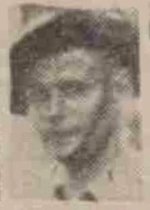 Charles Henry Whiting.
Charles Henry Whiting.
3780052 Pte. Charles Henry Whiting was the son of James Alfred and Anne Elizabeth Whiting and the husband of Ann Whiting, from Clayton in Manchester. Charles was another member of 5 Column on Operation Longcloth and sadly, he too perished inside Block 6 of Rangoon Jail on the 6th September 1943. His POW number was 584, supporting the claim that he was captured alongside Pte. Magill around the second week of May that year. He was originally buried at the English Cantonment Cemetery situated in the eastern sector of the city, close to the Royal Lakes. After the war his remains were re-interred at the newly constructed Rangoon War Cemetery.
From the pages of the Manchester Evening News, dated Saturday 9th June 1945:
Charles Henry Whiting (The King's Regiment), reported missing in Burma, May 11th 1943, now known to have died on September 6th 1943, whilst a prisoner of war in Japanese hands. Memories live longer than dreams. Your loving wife, Ann.
From the pages of the Manchester Evening News, dated Saturday 9th June 1945:
Charles Henry Whiting (The King's Regiment), reported missing in Burma, May 11th 1943, now known to have died on September 6th 1943, whilst a prisoner of war in Japanese hands. Memories live longer than dreams. Your loving wife, Ann.
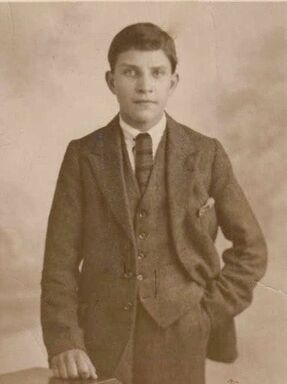 A young Harold Victor Cummings.
A young Harold Victor Cummings.
5116413 Pte. Harold Victor Cummings was originally a soldier with the Royal Warwickshire Regiment before he was transferred to the 13th King's on the 26th September 1942. He was one of the two dog-handlers with 5 Column, pairing up with another soldier named William Anders and their trusted mongrel bitch, Judy. According to a witness statement given by L/Cpl. F. Rowlands (shown in the Gallery below), Cummings was present with Samuel Carter, James Magill and Charles Whiting for a time on their march towards Fort Hertz. Pte. Cummings was lost to his dispersal group on the 28th April 1943 and was never seen or heard of again. He was born on the 18th August 1908 and was the son of Frederick and Minnie Cummings and the husband of Gladys Mary Victoria Cummings (nee Sayers). He is remembered upon Face 5 of the Rangoon Memorial.
4202457 Pte. Kenneth Dalrymple Webb was the son of L. Webb and Elsie J. Webb, from Sedgley, near Dudley in the West Midlands of England. Originally a member of 5 Column in 1943, he was one of the men separated from his unit after the ambush at Hintha on the 28th April and then joined up with 7 Column at the Shweli River. Kenneth is mentioned in a witness statement (seen below) given by CQMS. Ernest G. Henderson, after this NCO had returned to India. He was left in the village of Ying-Pu in early June and it is almost certain that he perished in this village having suffered with dysentery for many days. He was last seen by his commanding officer (Musgrave-Wood) on the 28th April 1943 and this is the recorded date of death on his CWGC details, however, it is clear that Kenneth Webb had pushed himself and his poor body on for several more weeks, before ultimately succumbing in early June that year. Pte. Webb is remembered upon Face 6 of the Rangoon Memorial.
4202457 Pte. Kenneth Dalrymple Webb was the son of L. Webb and Elsie J. Webb, from Sedgley, near Dudley in the West Midlands of England. Originally a member of 5 Column in 1943, he was one of the men separated from his unit after the ambush at Hintha on the 28th April and then joined up with 7 Column at the Shweli River. Kenneth is mentioned in a witness statement (seen below) given by CQMS. Ernest G. Henderson, after this NCO had returned to India. He was left in the village of Ying-Pu in early June and it is almost certain that he perished in this village having suffered with dysentery for many days. He was last seen by his commanding officer (Musgrave-Wood) on the 28th April 1943 and this is the recorded date of death on his CWGC details, however, it is clear that Kenneth Webb had pushed himself and his poor body on for several more weeks, before ultimately succumbing in early June that year. Pte. Webb is remembered upon Face 6 of the Rangoon Memorial.
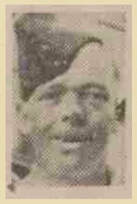
Pte. 3773352 Thomas Brown was another soldier originally with No. 5 Column on Operation Longcloth. He sadly died inside Block 6 of Rangoon Jail on the 11th August 1944. Pte. Brown, who was 35 years old when he perished in the prison had managed to survive for just over one year, before he too succumbed to the disease beri beri combined with the added complication of colitis. Thomas was from Huyton in Liverpool and was another original member of the 13th Battalion that travelled to India aboard the troopship 'Oronsay' on the 8th December 1941. According to his index card, Thomas' POW number was 309 and it states that he was captured on the 24th April 1943. He was buried at the English Cantonment Cemetery and his grave number was recorded as 199.
From the pages of the Liverpool Evening Express dated 13th October 1943:
Pte. Thomas Brown, aged 32 of 128 Cartmel Road, Huyton, is reported missing in an Indian theatre of war.
Update 07/09/2020.
I was delighted to receive an email contact from Lynn McNulty, whose mother was a cousin of Thomas Brown:
Dear Steve,
Thank you for your email replies and the information you have sent about Thomas Brown. I had scant details of Tommy's time in Burma, just his date of death and a photograph of his plaque at Rangoon, so the details and the photograph of him in your research were very welcome, although upsetting to see. I have spent a lot of time in the last few days following link after link on your website, both horrified and awed in turn at the stories of hardship endured and the resilience and courage of the men.
Although I never knew him, my late mother and my aunt spoke of him many times and I have been aware of him as far back as I can remember, but they had few details of his time in Burma as I got the impression it wasn’t talked about very much after the war. They used to say he was more like a brother than a cousin and even as elderly ladies they still mourned his loss. I was grateful to see the newspaper report in the Liverpool Echo which my Mum and her family sadly would have seen at the time and been most distressed. Both my grandfathers survived long periods as prisoners of war in the First World War and it is upsetting to think that Tommy and so many other men could have survived had they been given adequate treatment.
Tommy had a twin brother called Sammy, and I recall Mum saying he was injured on the troopship he was aboard and sent home. I thought of the pair of them when I read your story about the Dennett twins. I’m fairly sure that Tommy had no children, but he has at least one nephew and two nieces that I know of. One thing I do recall Mum telling me, is that another former POW visited Tommy’s parents after the war, but Mum didn’t know who he was or much of what was said, other than he said he had been there when they buried Tommy and that he had also seen Sammy, Tommy’s twin, who was very upset by the news. I have always wondered who that was?
Many thanks for all your invaluable research and information. Kind regards, Lynn.
Encouraged by the recent contact with Lynn, seen below is a gallery of images in relation to Thomas Brown, including a recent photograph of his grave at Rangoon War Cemetery. Please click on any image to bring it forward on the page.
From the pages of the Liverpool Evening Express dated 13th October 1943:
Pte. Thomas Brown, aged 32 of 128 Cartmel Road, Huyton, is reported missing in an Indian theatre of war.
Update 07/09/2020.
I was delighted to receive an email contact from Lynn McNulty, whose mother was a cousin of Thomas Brown:
Dear Steve,
Thank you for your email replies and the information you have sent about Thomas Brown. I had scant details of Tommy's time in Burma, just his date of death and a photograph of his plaque at Rangoon, so the details and the photograph of him in your research were very welcome, although upsetting to see. I have spent a lot of time in the last few days following link after link on your website, both horrified and awed in turn at the stories of hardship endured and the resilience and courage of the men.
Although I never knew him, my late mother and my aunt spoke of him many times and I have been aware of him as far back as I can remember, but they had few details of his time in Burma as I got the impression it wasn’t talked about very much after the war. They used to say he was more like a brother than a cousin and even as elderly ladies they still mourned his loss. I was grateful to see the newspaper report in the Liverpool Echo which my Mum and her family sadly would have seen at the time and been most distressed. Both my grandfathers survived long periods as prisoners of war in the First World War and it is upsetting to think that Tommy and so many other men could have survived had they been given adequate treatment.
Tommy had a twin brother called Sammy, and I recall Mum saying he was injured on the troopship he was aboard and sent home. I thought of the pair of them when I read your story about the Dennett twins. I’m fairly sure that Tommy had no children, but he has at least one nephew and two nieces that I know of. One thing I do recall Mum telling me, is that another former POW visited Tommy’s parents after the war, but Mum didn’t know who he was or much of what was said, other than he said he had been there when they buried Tommy and that he had also seen Sammy, Tommy’s twin, who was very upset by the news. I have always wondered who that was?
Many thanks for all your invaluable research and information. Kind regards, Lynn.
Encouraged by the recent contact with Lynn, seen below is a gallery of images in relation to Thomas Brown, including a recent photograph of his grave at Rangoon War Cemetery. Please click on any image to bring it forward on the page.
Seen below is a gallery of images in relation to some of men mentioned in the section directly above, including Herbert Boston, Arthur Dennett and Edward Barrett. Please click on any image to bring it forward on the page.
The following five men all returned safely to India after Operation Longcloth. Apart from being fortunate to survive the first Wingate expedition, these soldiers made it their business to assist the Army Investigation Bureau in providing information regarding the fate of some of their comrades who had not been so favoured. Many of the witness statements shown amongst the Galleries for this story, were supplied by the undermentioned soldiers and we shall be forever grateful to them for taking the time to write out these precious documents.
3773321 L/Cpl. F. J. Rowlands. Originally with 5 Column on Operation Longcloth, this soldier joined up with 7 Column at the Shweli River in early April 1943. He was one of the few men to return safely to India via Fort Hertz and alongside Lt. Musgrave-Wood. L/Cpl. Rowlands provided witness statements for Pte. Harold Cummings and the group of six men, including my own grandfather, who elected to remain at the village of Lonsa in May 1943.
5110875 Pte. J. Carless. This man was formerly with the Royal Warwickshire Regiment before being transferred to the 13th King's in September 1942. A member of 5 Column on Operation Longcloth, he fell seriously ill and was left in the village of Sima by Lt. George Astell of the Burma Rifles. Having regained his strength, Pte. Carless, alongside his fellow Chindit comrade, Pte. William Baddiley finally made it back to India on the 28th August 1943. He gave a witness statement in regards the fate of Pte. Kenneth Webb (see above).
5113882 Pte. William James Baddiley. Another former Royal Warwickshire soldier and a member of 5 Column in 1943, William was also left to recuperate in the village of Sima by Lt. Astell during the march out of Burma. It is highly probable that Ptes. Baddiley and Carless were the last Chindits to reach the safety of India under their own steam in 1943. To read more about this soldier, please click on the following link and scroll down the page: Baby Bios
3188857 CQMS. Ernest G. Henderson formerly of the King's Own Scottish Borderer's was another member of 5 Column on Operation Longcloth. This soldier provided many witness statements in regards to the missing and lost from the first Wingate expedition, including one for Pte. Kenneth Webb. Henderson made his own way out of Burma through Yunnan Province and was eventually picked up in the Chinese town of Dinjan. To read more about Ernest Henderson, please click on the following link and scroll down the page alphabetically: Roll Call F-J
2617400 L/Cpl. H. Lineker. This soldier was a former Grenadier Guardsman and a member of the Commando Section for 7 Column in 1943 (see nominal roll in the Gallery below). After his return to India he gave witness statements for Ptes. Harold Evans and Leslie Peace.
------------------------------------------------------------------------------------------------------
From the witness statement reference, 1016/35A, given by Lt. Musgrave-Wood on his return to Allied held territory in 1943:
Ptes. L. Peace, H. Evans and J. Masland of the 13th Battalion, King's Regiment, were members of a party being led by me from Burma back to India, during the months of April and May 1943. Pte. Masland sustained an injury to the heel of his right foot (not due to enemy action), which owing to lack of medical stores eventually turned septic. On the 6th May, Masland, during a halt at the village of Sima, reported to me that he did not think he was capable of marching any further. After a nights rest however, he said he would continue.
After marching for six hours, upon checking the personnel in the column, the above mentioned three men were missing. It was reported to me that, Pte. Masland had fallen out because of his foot and Peace and Evans were looking after him. They all intended to return to Sima, where my whole party had been well treated by the villagers. I waited on the the track for one hour and sent a party back to try and locate these men, this failed and I continued my march.
4467185 Pte. Leslie Simnet Peace, the son of Arthur and Ada Peace and husband of Dorothy Peace, from Stone in Staffordshire, was a commando in 7 Column on Operation Longcloth. He died on the 25th August 1943, probably in a Chinese village or hospital. From the information in Lt. Musgrave-Wood's witness report, it looks as though Leslie decided to remain with his fellow Chindit comrade, Pte. John Masland. The fact that Leslie has an actual grave at Taukkyan War Cemetery, means that his original burial was recorded by the Army Investigation Bureau, or that the Chinese village where he was laid to rest marked his last resting place and this could be identified after the war was over.
Update 11/03/2017.
On closer examination of the CWGC documentation for Leslie Peace, it has transpired that before his internment at Taukkyan War Cemetery, Leslie had previously been laid to rest at Mandalay Military Cemetery. From the very same document (shown in the gallery below), I made another intriguing discovery. Buried alongside Pte. Peace at Mandalay, were two other men from the 13th Battalion of the King's Regiment, who for one reason or another could not be identified. These graves were also re-interred at Taukkyan War Cemetery in 1951. Could it be, that one of the soldiers buried with his comrades at Mandalay, but whose identity could not ascertained by the Army Graves Registration Unit after the war, was none other than Pte. John Masland? Frustratingly, we shall probably never know.
Update 31/07/2017.
From information now received, it seems that Leslie Peace had in fact fallen into enemy hands towards the closing stages of Operation Longcloth. The Staffordshire Advertiser newspaper carried this short report in an issue dated 13th October 1945:
Stone Man Died in Captivity
News has been received by Mrs. Dorothy Peace of 11 Radford Street, Stone, that her husband, Pte. Leslie Peace, the King's Regiment, died of dysentery in a Japanese prison camp on, or about the 25th August 1943. Pte. Peace joined the Army in 1940 and took part in General Wingate's first expedition into Burma, from which he was reported missing. Previous to joining the Forces, he was employed by Messrs. Timothy Whites and Taylors, the chemists in Stone.
With this latest information, it seems likely that Pte. Peace was being held at the concentration camp at Maymyo and had fallen ill with dysentery as the Chindit prisoners were being prepared to move down to Rangoon Jail. This would account for his initial interment at the Mandalay, which is around 50 miles from Maymyo and was where the men were loaded aboard cattle trucks to make the long journey to Rangoon.
4468945 Pte. John Masland was the son of Joseph and Ann Masland, from Blyth in Northumberland. He was also a commando in 7 Column during the first Wingate expedition. As mentioned in the statement by Lt. Musgrave-Wood, John developed a sceptic foot on the march out via the Chinese Borders and was left behind in the village of Sima on the 6th May 1943. He died sometime in late July 1943, probably in some form of Chinese Hospital. Sadly, his grave was never recovered after the war and for this reason he is remembered upon Face 5 of the Rangoon Memorial. Both John Masland and Leslie Peace had served with the Durham Light Infantry Regiment before being transferred to the 13th King's in September 1942.
2574617 Pte. Harold Evans, a soldier formerly with the Worcestershire Regiment, was the son of Samuel Evans and of Ada Rose Evans, from Brampton in Derbyshire. Harold was also a 7 Column commando under the leadership of Lt. John Hubert Trigg and as already mentioned had decided to stay with his friend John Masland, when this soldier fell out from the march towards Fort Hertz. Nothing further is known about Pte. Evans, other than his recorded date of death was the 1st August 1943 and that he had been buried originally at the Mandalay Military Cemetery, before being moved after the war to Taukkyan War Cemetery on the northern outskirts of Rangoon.
Update 17/09/2017.
I was pleased to receive the following email contact from Scott Towns, a relative by marriage to wider Evans family:
My Father-in-Law is researching his uncle on his father's side, Private 2574617 Harold Evans. He was killed in Burma on 1st August 1943 and your site mentions him from the witness statement reference 1016/35A given by Lt. Musgrave-Wood on his return to Allied territory in 1943. Would you happen to have any other information about Harold? We would very much like to know more about his life and of course his death. We have the picture of his grave plaque from your site now, which is an extremely moving thing to see. We hope to hear back from you soon.
I replied to Scott:
Thank you for your email contact via my website. I was very pleased to hear that you found my site and read the information about Harold. I'm afraid that everything I know about him was placed onto the pages regarding Lt. Musgrave-Wood. I would love to learn more about Harold from the family, his early life, work etc. Also, it would be wonderful to see a photograph of him if one exists. In the meantime, I will gather together all the papers I have in relation to Pte. Evans and send them on to you. Best wishes. Steve
Scott sent this reply shortly afterwards:
Steve
Thank you so much for the documents and papers. It looks unlikely that we will have any photos of Harold, but if we do find anything, I'll forward it on. I really appreciate your efforts. My Father-in-Law has found real solace from finally knowing a little more about what happened to his dear uncle in Burma.
Seen below is a Gallery of images in relation to the soldiers mentioned in this section of the story. Please click on any image to bring it forward on the page.
3773321 L/Cpl. F. J. Rowlands. Originally with 5 Column on Operation Longcloth, this soldier joined up with 7 Column at the Shweli River in early April 1943. He was one of the few men to return safely to India via Fort Hertz and alongside Lt. Musgrave-Wood. L/Cpl. Rowlands provided witness statements for Pte. Harold Cummings and the group of six men, including my own grandfather, who elected to remain at the village of Lonsa in May 1943.
5110875 Pte. J. Carless. This man was formerly with the Royal Warwickshire Regiment before being transferred to the 13th King's in September 1942. A member of 5 Column on Operation Longcloth, he fell seriously ill and was left in the village of Sima by Lt. George Astell of the Burma Rifles. Having regained his strength, Pte. Carless, alongside his fellow Chindit comrade, Pte. William Baddiley finally made it back to India on the 28th August 1943. He gave a witness statement in regards the fate of Pte. Kenneth Webb (see above).
5113882 Pte. William James Baddiley. Another former Royal Warwickshire soldier and a member of 5 Column in 1943, William was also left to recuperate in the village of Sima by Lt. Astell during the march out of Burma. It is highly probable that Ptes. Baddiley and Carless were the last Chindits to reach the safety of India under their own steam in 1943. To read more about this soldier, please click on the following link and scroll down the page: Baby Bios
3188857 CQMS. Ernest G. Henderson formerly of the King's Own Scottish Borderer's was another member of 5 Column on Operation Longcloth. This soldier provided many witness statements in regards to the missing and lost from the first Wingate expedition, including one for Pte. Kenneth Webb. Henderson made his own way out of Burma through Yunnan Province and was eventually picked up in the Chinese town of Dinjan. To read more about Ernest Henderson, please click on the following link and scroll down the page alphabetically: Roll Call F-J
2617400 L/Cpl. H. Lineker. This soldier was a former Grenadier Guardsman and a member of the Commando Section for 7 Column in 1943 (see nominal roll in the Gallery below). After his return to India he gave witness statements for Ptes. Harold Evans and Leslie Peace.
------------------------------------------------------------------------------------------------------
From the witness statement reference, 1016/35A, given by Lt. Musgrave-Wood on his return to Allied held territory in 1943:
Ptes. L. Peace, H. Evans and J. Masland of the 13th Battalion, King's Regiment, were members of a party being led by me from Burma back to India, during the months of April and May 1943. Pte. Masland sustained an injury to the heel of his right foot (not due to enemy action), which owing to lack of medical stores eventually turned septic. On the 6th May, Masland, during a halt at the village of Sima, reported to me that he did not think he was capable of marching any further. After a nights rest however, he said he would continue.
After marching for six hours, upon checking the personnel in the column, the above mentioned three men were missing. It was reported to me that, Pte. Masland had fallen out because of his foot and Peace and Evans were looking after him. They all intended to return to Sima, where my whole party had been well treated by the villagers. I waited on the the track for one hour and sent a party back to try and locate these men, this failed and I continued my march.
4467185 Pte. Leslie Simnet Peace, the son of Arthur and Ada Peace and husband of Dorothy Peace, from Stone in Staffordshire, was a commando in 7 Column on Operation Longcloth. He died on the 25th August 1943, probably in a Chinese village or hospital. From the information in Lt. Musgrave-Wood's witness report, it looks as though Leslie decided to remain with his fellow Chindit comrade, Pte. John Masland. The fact that Leslie has an actual grave at Taukkyan War Cemetery, means that his original burial was recorded by the Army Investigation Bureau, or that the Chinese village where he was laid to rest marked his last resting place and this could be identified after the war was over.
Update 11/03/2017.
On closer examination of the CWGC documentation for Leslie Peace, it has transpired that before his internment at Taukkyan War Cemetery, Leslie had previously been laid to rest at Mandalay Military Cemetery. From the very same document (shown in the gallery below), I made another intriguing discovery. Buried alongside Pte. Peace at Mandalay, were two other men from the 13th Battalion of the King's Regiment, who for one reason or another could not be identified. These graves were also re-interred at Taukkyan War Cemetery in 1951. Could it be, that one of the soldiers buried with his comrades at Mandalay, but whose identity could not ascertained by the Army Graves Registration Unit after the war, was none other than Pte. John Masland? Frustratingly, we shall probably never know.
Update 31/07/2017.
From information now received, it seems that Leslie Peace had in fact fallen into enemy hands towards the closing stages of Operation Longcloth. The Staffordshire Advertiser newspaper carried this short report in an issue dated 13th October 1945:
Stone Man Died in Captivity
News has been received by Mrs. Dorothy Peace of 11 Radford Street, Stone, that her husband, Pte. Leslie Peace, the King's Regiment, died of dysentery in a Japanese prison camp on, or about the 25th August 1943. Pte. Peace joined the Army in 1940 and took part in General Wingate's first expedition into Burma, from which he was reported missing. Previous to joining the Forces, he was employed by Messrs. Timothy Whites and Taylors, the chemists in Stone.
With this latest information, it seems likely that Pte. Peace was being held at the concentration camp at Maymyo and had fallen ill with dysentery as the Chindit prisoners were being prepared to move down to Rangoon Jail. This would account for his initial interment at the Mandalay, which is around 50 miles from Maymyo and was where the men were loaded aboard cattle trucks to make the long journey to Rangoon.
4468945 Pte. John Masland was the son of Joseph and Ann Masland, from Blyth in Northumberland. He was also a commando in 7 Column during the first Wingate expedition. As mentioned in the statement by Lt. Musgrave-Wood, John developed a sceptic foot on the march out via the Chinese Borders and was left behind in the village of Sima on the 6th May 1943. He died sometime in late July 1943, probably in some form of Chinese Hospital. Sadly, his grave was never recovered after the war and for this reason he is remembered upon Face 5 of the Rangoon Memorial. Both John Masland and Leslie Peace had served with the Durham Light Infantry Regiment before being transferred to the 13th King's in September 1942.
2574617 Pte. Harold Evans, a soldier formerly with the Worcestershire Regiment, was the son of Samuel Evans and of Ada Rose Evans, from Brampton in Derbyshire. Harold was also a 7 Column commando under the leadership of Lt. John Hubert Trigg and as already mentioned had decided to stay with his friend John Masland, when this soldier fell out from the march towards Fort Hertz. Nothing further is known about Pte. Evans, other than his recorded date of death was the 1st August 1943 and that he had been buried originally at the Mandalay Military Cemetery, before being moved after the war to Taukkyan War Cemetery on the northern outskirts of Rangoon.
Update 17/09/2017.
I was pleased to receive the following email contact from Scott Towns, a relative by marriage to wider Evans family:
My Father-in-Law is researching his uncle on his father's side, Private 2574617 Harold Evans. He was killed in Burma on 1st August 1943 and your site mentions him from the witness statement reference 1016/35A given by Lt. Musgrave-Wood on his return to Allied territory in 1943. Would you happen to have any other information about Harold? We would very much like to know more about his life and of course his death. We have the picture of his grave plaque from your site now, which is an extremely moving thing to see. We hope to hear back from you soon.
I replied to Scott:
Thank you for your email contact via my website. I was very pleased to hear that you found my site and read the information about Harold. I'm afraid that everything I know about him was placed onto the pages regarding Lt. Musgrave-Wood. I would love to learn more about Harold from the family, his early life, work etc. Also, it would be wonderful to see a photograph of him if one exists. In the meantime, I will gather together all the papers I have in relation to Pte. Evans and send them on to you. Best wishes. Steve
Scott sent this reply shortly afterwards:
Steve
Thank you so much for the documents and papers. It looks unlikely that we will have any photos of Harold, but if we do find anything, I'll forward it on. I really appreciate your efforts. My Father-in-Law has found real solace from finally knowing a little more about what happened to his dear uncle in Burma.
Seen below is a Gallery of images in relation to the soldiers mentioned in this section of the story. Please click on any image to bring it forward on the page.
I was with a dispersal group commanded by Lieutenant Musgrave-Wood. On approximately the 12th May 1943 Pte. Lowe elected to leave our group, accompanied by, Lance Corporal Jordan, Lance Corporal Ambrose, Pte. Burger, Pte. Franks and Pte. Howney. They left us at the village of Lonsa.
The above quote is taken from the witness statement of Private F.J. Rowlands of the King's Regiment, as recited by him to the Army Investigation Bureau back in India on 14th July 1943. In another report made by Lt. Musgrave-Wood, it seems that the same group of six men decided to remain at Lonsa, due to their exhausted condition and with the intention to rest there for a while, before continuing their march north to Fort Hertz. From the report it is known that the six were still free men on the 12th May, but it is unclear why Leon Frank, originally a soldier with 7 Column, had joined up with the other five men who were all from Column 5.
The natural leader of the group in terms of soldiering skill and experience should have been Pte. Fred Lowe, who had been part of the Guerrilla Platoon and 142 Commando in 5 Column and would have come into the operation with more survival related training than any of the other men. However, it would transpire that Lance Corporal William Jordan took up the lead role within the group as they resumed their march towards the Chinese border.
Pte. Leon Frank recalled:
We realised that our party was too large and an obvious target, so our Lieutenant (Musgrave-Wood) told us it was every man for himself. Myself and five others, including Lance Corporal Jordan, decided to go east and try and get into China. We became like bandits; we would go into villages and demand rice and food at gunpoint. We eventually came to a hillside with a hut on the side of it and a stream below and settled down to rest. Someone should have been on guard but we were totally exhausted. Next thing we knew the door burst open and in came a Jap soldier with a fixed bayonet and stabbed Jordan in the hand. He was about to have another go when an officer called him off. We walked outside to find a half moon of Japanese soldiers with a machine-gun in the centre, pointed at us. This was the beginning of our time as prisoners of war.
The natural leader of the group in terms of soldiering skill and experience should have been Pte. Fred Lowe, who had been part of the Guerrilla Platoon and 142 Commando in 5 Column and would have come into the operation with more survival related training than any of the other men. However, it would transpire that Lance Corporal William Jordan took up the lead role within the group as they resumed their march towards the Chinese border.
Pte. Leon Frank recalled:
We realised that our party was too large and an obvious target, so our Lieutenant (Musgrave-Wood) told us it was every man for himself. Myself and five others, including Lance Corporal Jordan, decided to go east and try and get into China. We became like bandits; we would go into villages and demand rice and food at gunpoint. We eventually came to a hillside with a hut on the side of it and a stream below and settled down to rest. Someone should have been on guard but we were totally exhausted. Next thing we knew the door burst open and in came a Jap soldier with a fixed bayonet and stabbed Jordan in the hand. He was about to have another go when an officer called him off. We walked outside to find a half moon of Japanese soldiers with a machine-gun in the centre, pointed at us. This was the beginning of our time as prisoners of war.
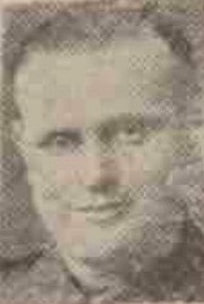 Fred Lowe.
Fred Lowe.
4202396 Pte. Fred Lowe formerly of the Royal Welch Fusiliers, joined the 13th King's at their training camp in Saugor on the 30th September 1942. He was then posted to 5 Column, serving with the Commando Platoon in Burma. Fred was one of the men separated from his column during the enemy ambush at Hintha. He became part of the dispersal party led by Lt. Musgrave-Wood, but was captured at Lonsa village in May 1943 along with my grandfather and the other four soldiers mentioned in Pte. Rowlands witness statement. Sadly, Fred died from a heart attack, shortly after arriving in Rangoon on the 22nd May. He was originally buried at St. Mary's Catholic Church, before his remains were moved over to the newly constructed Rangoon War Cemetery after the war.
Update 18/04/2017.
From the pages of the Manchester Evening News dated 16th April 1945 and under the headline:
Birthday Greetings:
Loving birthday greetings to our dear son Fred Lowe, King's Regiment, missing in Burma 1943. Our greatest wish your safe return. From Mam, Charlie (RASC), Tom (RASC), Walter (MEF), Frank (RA), Ada, Irene and Harry.
It is so very sad to think that Fred had already been dead the best part of two years when the family wrote down this heartfelt message. The photograph of Fred Lowe was first published in the Manchester Evening News on the 22nd July 1943.
Update 18/04/2017.
From the pages of the Manchester Evening News dated 16th April 1945 and under the headline:
Birthday Greetings:
Loving birthday greetings to our dear son Fred Lowe, King's Regiment, missing in Burma 1943. Our greatest wish your safe return. From Mam, Charlie (RASC), Tom (RASC), Walter (MEF), Frank (RA), Ada, Irene and Harry.
It is so very sad to think that Fred had already been dead the best part of two years when the family wrote down this heartfelt message. The photograph of Fred Lowe was first published in the Manchester Evening News on the 22nd July 1943.
5124637 Pte. Edgar Burger formerly of the Royal Warwickshire Regiment, was transferred to the 13th King's on the 26th September 1942. Edgar was a strong swimmer and was chosen by Bernard Fergusson to teach some of the other members of 5 Column how to swim during the training period at Saugor. He was captured at Lonsa village in May 1943 and perished inside Block 6 of Rangoon Jail on the 28th September that same year. Pte. Burger had been given the POW no. 453 in Rangoon Jail and was buried at the English Cantonment Cemetery. No POW index card exists for Edgar Burger and therefore nothing else is known about his fate as a prisoner of war.
3777671 L/Cpl. James Richard Ambrose was posted to 5 Column during Chindit training in the Central Provinces of India. James was another soldier separated from his column at Hintha on the 28th March 1943 and who teamed up with Lt. Musgrave-Wood on dispersal at the Shweli River. Captured at Lonsa along with Ptes. Frank, Howney, Burger and Lowe and L/Cpl. Jordan, James sadly perished inside Block 6 of Rangoon Jail on the 8th November 1943. There is no POW index card for James Ambrose and therefore little is known about his time as a prisoner of war, although we do know that his POW number was 426 and that he was buried at the English Cantonment Cemetery with the grave reference 117. To read more about this soldier, please click on the following link and scroll down to the relevant section on the page: Family 2
3657118 L/Cpl. William Robert Jordan MM, was the son of Robert and Annie Jordan and the husband of Gladys Jordan, from Failsworth near Oldham in Lancashire. He enlisted into the South Lancashire Regiment, before being transferred to the 13th King's in India during the autumn of 1942. William was posted to 5 Column and was possibly a member of Lt. John Kerr's platoon during the early weeks inside Burma. L/Cpl. Jordan was another soldier separated from his column at Hintha on the 28th March 1943 and who teamed up with Lt. Musgrave-Wood on dispersal at the Shweli River. After falling into enemy hands at the village of Lonsa, William sadly died inside Block 6 of Rangoon Jail on the 1st March 1944 and was buried at the English Cantonment Cemetery. Although no other documents are available, we do know that William Jordan's POW number was 428 and that his remains were re-interred at Rangoon War Cemetery after the war. To read more about this soldier, please click on the following link and scroll down to the relevant section on the page: Family 2
5629998 Pte. Arthur Leslie Howney enlisted into the British Army in December 1940 and was originally posted to the 9th Battalion of the Devonshire Regiment. He was then transferred to the 13th King's, joining them at their Chindit training base in Saugor on the 26th September 1942. Arthur was attached to 5 Column at Saugor, but his platoon placement is not known at this time. Separated from 5 Column after the ambush at Hintha, he also teamed up with 7 Column and became a member of Lt. Musgrave-Wood's dispersal party at the Shweli River. Captured at the village of Lonsa in mid-May, Pte. Howney died inside Block 6 of Rangoon Jail on the 19th June 1943, according to his POW index card he was suffering from both malaria and severe malnutrition and had been allocated the POW number 420. He was buried alongside his Chindit comrades at the English Cantonment Cemetery in the eastern sector of the city, close to the Royal Lakes. To read more about Pte. Howney, please click on the following link: Arthur Leslie Howney
3780682 Pte. Leonard Frank was a muleteer in 7 Column during Operation Longcloth and served in No. 13 Platoon under the command of Captain W.B.E. Petersen, a Danish officer with a Special Forces background. On column dispersal at the Shweli River, Leon was allocated to the group led by Lt. Musgrave-Wood. Captured at Lonsa village in mid-May 1943, Pte. Frank was the only member from the group of six men featured in this section of the story, to survive his time in enemy hands and was liberated on the 29th April 1945. To read more about this soldier, please click on the following link: Pte. Leon Frank
Seen below is another Gallery of images in relation to this section of the story, please click on any image to bring it forward on the page.
3777671 L/Cpl. James Richard Ambrose was posted to 5 Column during Chindit training in the Central Provinces of India. James was another soldier separated from his column at Hintha on the 28th March 1943 and who teamed up with Lt. Musgrave-Wood on dispersal at the Shweli River. Captured at Lonsa along with Ptes. Frank, Howney, Burger and Lowe and L/Cpl. Jordan, James sadly perished inside Block 6 of Rangoon Jail on the 8th November 1943. There is no POW index card for James Ambrose and therefore little is known about his time as a prisoner of war, although we do know that his POW number was 426 and that he was buried at the English Cantonment Cemetery with the grave reference 117. To read more about this soldier, please click on the following link and scroll down to the relevant section on the page: Family 2
3657118 L/Cpl. William Robert Jordan MM, was the son of Robert and Annie Jordan and the husband of Gladys Jordan, from Failsworth near Oldham in Lancashire. He enlisted into the South Lancashire Regiment, before being transferred to the 13th King's in India during the autumn of 1942. William was posted to 5 Column and was possibly a member of Lt. John Kerr's platoon during the early weeks inside Burma. L/Cpl. Jordan was another soldier separated from his column at Hintha on the 28th March 1943 and who teamed up with Lt. Musgrave-Wood on dispersal at the Shweli River. After falling into enemy hands at the village of Lonsa, William sadly died inside Block 6 of Rangoon Jail on the 1st March 1944 and was buried at the English Cantonment Cemetery. Although no other documents are available, we do know that William Jordan's POW number was 428 and that his remains were re-interred at Rangoon War Cemetery after the war. To read more about this soldier, please click on the following link and scroll down to the relevant section on the page: Family 2
5629998 Pte. Arthur Leslie Howney enlisted into the British Army in December 1940 and was originally posted to the 9th Battalion of the Devonshire Regiment. He was then transferred to the 13th King's, joining them at their Chindit training base in Saugor on the 26th September 1942. Arthur was attached to 5 Column at Saugor, but his platoon placement is not known at this time. Separated from 5 Column after the ambush at Hintha, he also teamed up with 7 Column and became a member of Lt. Musgrave-Wood's dispersal party at the Shweli River. Captured at the village of Lonsa in mid-May, Pte. Howney died inside Block 6 of Rangoon Jail on the 19th June 1943, according to his POW index card he was suffering from both malaria and severe malnutrition and had been allocated the POW number 420. He was buried alongside his Chindit comrades at the English Cantonment Cemetery in the eastern sector of the city, close to the Royal Lakes. To read more about Pte. Howney, please click on the following link: Arthur Leslie Howney
3780682 Pte. Leonard Frank was a muleteer in 7 Column during Operation Longcloth and served in No. 13 Platoon under the command of Captain W.B.E. Petersen, a Danish officer with a Special Forces background. On column dispersal at the Shweli River, Leon was allocated to the group led by Lt. Musgrave-Wood. Captured at Lonsa village in mid-May 1943, Pte. Frank was the only member from the group of six men featured in this section of the story, to survive his time in enemy hands and was liberated on the 29th April 1945. To read more about this soldier, please click on the following link: Pte. Leon Frank
Seen below is another Gallery of images in relation to this section of the story, please click on any image to bring it forward on the page.
Two other men from Lt. Musgrave-Wood's dispersal party managed to survive their time as prisoners of war in 1943:
3452862 L/Cpl. William S. Gallon formerly of the Lancashire Fusiliers, was transferred to the 13th King's on the 30th September 1942 and was posted to 7 Column under the command of Major Kenneth Gilkes. William, originally from Newcastle-upon-Tyne, was staying at a friendly Kachin village when he was taken prisoner by the Japanese on the 29th June 1943. A witness statement from Pte. J. Carless (seen in the Gallery below) suggests that L/Cpl. Gallon was with Pte. Joseph Moran and Pte. Ivor Williams at the time. After just under two years inside Rangoon Jail, William was liberated close to the Burmese town of Pegu on the 29th April 1945. Please see his POW index card in the Gallery below.
Update 19/04/2019.
From a witness statement written by Chindit commander, Major Kenneth Gilkes in November 1943, there is now more information about the last known movements of William Gallon:
Pte. W.S. Gallon was lost to the column in the Kachin Hills between Sima and Sadon villages. The populations here were very friendly and he had sufficient money.
3856940 Pte. Joseph Moran formerly of the Loyal Regiment, was transferred to the 13th King's on the 30th September 1942. He was posted to the commando section for 7 Column under the leadership of Lt. J. Trigg of the Royal Engineers. Joseph was captured by the Japanese on the 29th June 1943, the same day as and presumably alongside L/Cpl. Gallon. Previously, on the 8th April this soldier had been left in the Burmese village of Uma, suffering from a gun-shot wound to his side. Joseph was liberated along with some 400 other POW's from Rangoon Jail, on the Pegu Road in late April 1945. Please see his POW index card in the Gallery below.
Private 5120086 Harold Baxter formerly of the Royal Warwickshire Regiment, was transferred to the 13th King's on the 26th September 1942 and took up his place in No. 7 Platoon of 5 Column which was commanded by Lt. Philip Stibbe. He had caused consternation, and some amusement, when he lost his Bren gun and the mule carrying it, down a large water well at the village of Saugor during training. After the ambush at Hintha, Pte. Baxter joined up with 7 Column at the Shweli River and was allocated to the dispersal party led by Lt. Musgrave -Wood. Harold sadly perished on the 29th April 1943, although the following witness statement from Ptes. Baddiley and Carless suggest it was a little later:
“Pte. H. Baxter died early in May. He was suffering from beri beri and would no longer eat. He was buried in our presence at the village of Sima, which lies to the south of Fort Morton."
Pte. Baxter's body was never recovered after the war and therefore he is remembered upon Face 5 of the Rangoon Memorial.
5119828 Pte. Allen Arthur Whiston formerly of the Royal Warwickshire Regiment, was the son of William George and Helen Whiston and husband of Nellie Louise Whiston from Aston in Birmingham. Allen joined Chindit training at the Saugor Camp on the 26th September 1942 and was posted to 5 Column. After joining Lt. Musgrave-Wood's dispersal party at the Shweli River, Pte. Whiston went missing towards the end of April 1943 and was last seen on the roadside just north of a place called Fort Morton. His body was never recovered and so Allen is remembered upon Face 6 of the Rangoon Memorial.
3779280 Pte. Henry Walmsley of the King's Regiment, was the son of Joseph and Susan Walmsley, from Bootle in Lancashire. Henry was attached to 5 Column at the Saugor Camp and was another soldier separated from the column after their ambush at Hintha on the 28th March 1943. He also teamed up with 7 Column and became a member of Lt. Musgrave-Wood's dispersal party at the Shweli River. Pte. Walmsley died in hospital on the 23rd June 1943 at Paoshan, a Chinese town located in Yunnan Province, his cause of death was not recorded. Henry was buried after the war at the Sai Wan War Cemetery in north-east Hong Kong.
3452862 L/Cpl. William S. Gallon formerly of the Lancashire Fusiliers, was transferred to the 13th King's on the 30th September 1942 and was posted to 7 Column under the command of Major Kenneth Gilkes. William, originally from Newcastle-upon-Tyne, was staying at a friendly Kachin village when he was taken prisoner by the Japanese on the 29th June 1943. A witness statement from Pte. J. Carless (seen in the Gallery below) suggests that L/Cpl. Gallon was with Pte. Joseph Moran and Pte. Ivor Williams at the time. After just under two years inside Rangoon Jail, William was liberated close to the Burmese town of Pegu on the 29th April 1945. Please see his POW index card in the Gallery below.
Update 19/04/2019.
From a witness statement written by Chindit commander, Major Kenneth Gilkes in November 1943, there is now more information about the last known movements of William Gallon:
Pte. W.S. Gallon was lost to the column in the Kachin Hills between Sima and Sadon villages. The populations here were very friendly and he had sufficient money.
3856940 Pte. Joseph Moran formerly of the Loyal Regiment, was transferred to the 13th King's on the 30th September 1942. He was posted to the commando section for 7 Column under the leadership of Lt. J. Trigg of the Royal Engineers. Joseph was captured by the Japanese on the 29th June 1943, the same day as and presumably alongside L/Cpl. Gallon. Previously, on the 8th April this soldier had been left in the Burmese village of Uma, suffering from a gun-shot wound to his side. Joseph was liberated along with some 400 other POW's from Rangoon Jail, on the Pegu Road in late April 1945. Please see his POW index card in the Gallery below.
Private 5120086 Harold Baxter formerly of the Royal Warwickshire Regiment, was transferred to the 13th King's on the 26th September 1942 and took up his place in No. 7 Platoon of 5 Column which was commanded by Lt. Philip Stibbe. He had caused consternation, and some amusement, when he lost his Bren gun and the mule carrying it, down a large water well at the village of Saugor during training. After the ambush at Hintha, Pte. Baxter joined up with 7 Column at the Shweli River and was allocated to the dispersal party led by Lt. Musgrave -Wood. Harold sadly perished on the 29th April 1943, although the following witness statement from Ptes. Baddiley and Carless suggest it was a little later:
“Pte. H. Baxter died early in May. He was suffering from beri beri and would no longer eat. He was buried in our presence at the village of Sima, which lies to the south of Fort Morton."
Pte. Baxter's body was never recovered after the war and therefore he is remembered upon Face 5 of the Rangoon Memorial.
5119828 Pte. Allen Arthur Whiston formerly of the Royal Warwickshire Regiment, was the son of William George and Helen Whiston and husband of Nellie Louise Whiston from Aston in Birmingham. Allen joined Chindit training at the Saugor Camp on the 26th September 1942 and was posted to 5 Column. After joining Lt. Musgrave-Wood's dispersal party at the Shweli River, Pte. Whiston went missing towards the end of April 1943 and was last seen on the roadside just north of a place called Fort Morton. His body was never recovered and so Allen is remembered upon Face 6 of the Rangoon Memorial.
3779280 Pte. Henry Walmsley of the King's Regiment, was the son of Joseph and Susan Walmsley, from Bootle in Lancashire. Henry was attached to 5 Column at the Saugor Camp and was another soldier separated from the column after their ambush at Hintha on the 28th March 1943. He also teamed up with 7 Column and became a member of Lt. Musgrave-Wood's dispersal party at the Shweli River. Pte. Walmsley died in hospital on the 23rd June 1943 at Paoshan, a Chinese town located in Yunnan Province, his cause of death was not recorded. Henry was buried after the war at the Sai Wan War Cemetery in north-east Hong Kong.
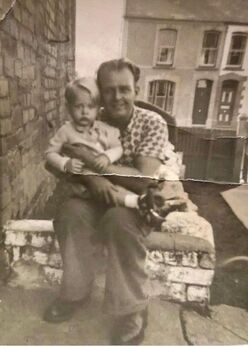 Ivor Williams pre-WW2.
Ivor Williams pre-WW2.
4197554 Pte. Ivor Sidney Williams formerly of the Royal Welch Fusiliers, was the son of Rees and Betty Williams from Swansea in South Wales. This soldier was posted to No. 5 Column at the Saugor Camp on the 30th September 1942 and was known for his beautiful singing voice, which could be heard on many occasions during the training period. Pte. Williams was separated from 5 Column on the 28th March 1943 after the column were ambushed just outside of the village of Hintha. He was captured on the 3rd July 1943, and had reportedly travelled with L/Cpl. Gallon and Pte. Joseph Moran for a period shortly before that date.
Ivor Williams, whose POW number was 388, died inside Block 6 of Rangoon Jail on the 26th August 1944. He was one of the very unfortunate soldiers held at the jail to contract the disease cholera and was cremated in the prison compound shortly after his death. Pte. Williams' remains now rest at Rangoon War Cemetery, sharing a grave with Corporal William Burbidge of the Duke of Wellington Regiment and L/Cpl. Mervyn Charles Lewis of the West Yorkshire Regiment, both of whom perished inside Rangoon Jail as the result of the cholera outbreak.
Update 06/10/2020.
I was delighted to receive the following email contact from Ellie Rendall, who is the great niece of Pte. Ivor Williams:
I am the great niece of Private Ivor Williams who is mentioned a few times on your site, he died on 27th June 1944 in Rangoon prison. My mother has a photo of him which I can send to you if it is something that you are interested in. Only today after reading your website, have I learned the true fate of Ivor and it has been very interesting although extremely sad.
Sadly, I don't know a great deal about him, he was the elder brother of my grandfather and the third son of 11 children, my grandfather was the 10th born. My own grandfather passed away 20 years ago and it wasn't until then that we discovered the photo of Ivor and at that point it was too late to ask that much about him. I do know that his sister Betty visited the grave in the 1980s and I would love to do so in the future. I am visiting my parents tomorrow and will search for the photo, he is in uniform if I remember. It is still a mystery to us why he moved to the King's Liverpool Regiment from the RWF?
I am fascinated by military history and discovering these details makes me very proud. If you could provide further details/documents that would be fantastic. Thank you again, Ellie.
I was able to send Ellie several documents in relation to her great uncle some of which are displayed in the gallery below. I would like to thank her for contacting me and look forward to seeing the photograph of Ivor in the near future.
Seen below is another gallery of images in relation to this final section of the story regarding the men from the dispersal party led by Lt. Musgrave-Wood in April/May 1943. Please click on any image to bring it forward on the page.
Ivor Williams, whose POW number was 388, died inside Block 6 of Rangoon Jail on the 26th August 1944. He was one of the very unfortunate soldiers held at the jail to contract the disease cholera and was cremated in the prison compound shortly after his death. Pte. Williams' remains now rest at Rangoon War Cemetery, sharing a grave with Corporal William Burbidge of the Duke of Wellington Regiment and L/Cpl. Mervyn Charles Lewis of the West Yorkshire Regiment, both of whom perished inside Rangoon Jail as the result of the cholera outbreak.
Update 06/10/2020.
I was delighted to receive the following email contact from Ellie Rendall, who is the great niece of Pte. Ivor Williams:
I am the great niece of Private Ivor Williams who is mentioned a few times on your site, he died on 27th June 1944 in Rangoon prison. My mother has a photo of him which I can send to you if it is something that you are interested in. Only today after reading your website, have I learned the true fate of Ivor and it has been very interesting although extremely sad.
Sadly, I don't know a great deal about him, he was the elder brother of my grandfather and the third son of 11 children, my grandfather was the 10th born. My own grandfather passed away 20 years ago and it wasn't until then that we discovered the photo of Ivor and at that point it was too late to ask that much about him. I do know that his sister Betty visited the grave in the 1980s and I would love to do so in the future. I am visiting my parents tomorrow and will search for the photo, he is in uniform if I remember. It is still a mystery to us why he moved to the King's Liverpool Regiment from the RWF?
I am fascinated by military history and discovering these details makes me very proud. If you could provide further details/documents that would be fantastic. Thank you again, Ellie.
I was able to send Ellie several documents in relation to her great uncle some of which are displayed in the gallery below. I would like to thank her for contacting me and look forward to seeing the photograph of Ivor in the near future.
Seen below is another gallery of images in relation to this final section of the story regarding the men from the dispersal party led by Lt. Musgrave-Wood in April/May 1943. Please click on any image to bring it forward on the page.
Copyright © Steve Fogden, March 2017.
